Iconic Animals of the Australian Outback
Explore the wildlife and natural heritage of Australia, with its iconic marsupials, birds, reptiles, and surreal monotremes in the Outback. Odyssey offers small group tours for mature and senior travellers, couples, and solo travelers to Australia.
2 Apr 21 · 15 mins read
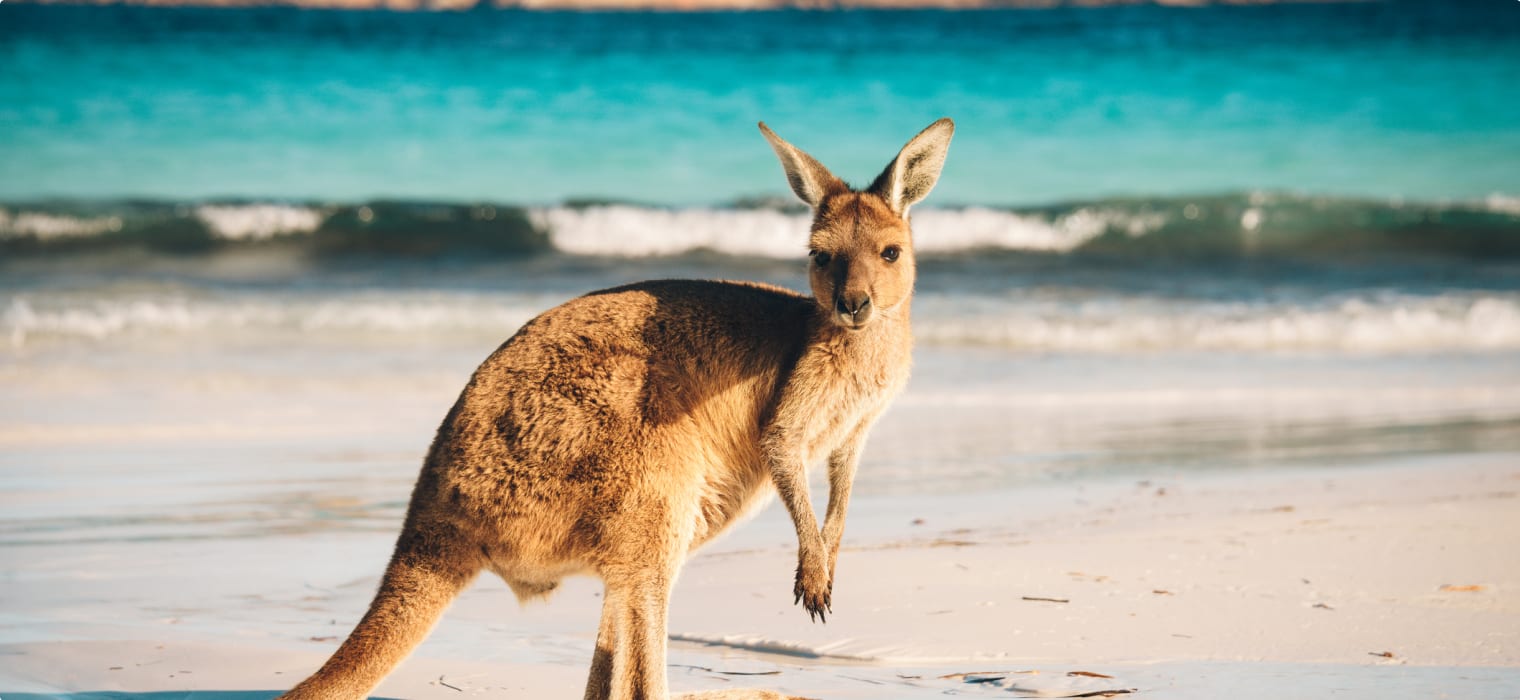
Iconic Animals of the Australian Outback
When it comes to Australia‘s iconic wildlife, the more well known faces of the Kangaroo, Emu, or Koala generally spring to mind. But for many Australians, or visitors from abroad, it can be easy to forget the incredible diversity of wildlife that inhabits this enormous continent, ranging from the weird to the wondrous. Australia‘s distinctive biodiversity has evolved independently over time due to its incredibly long period of geographic isolation from the rest of the world, with the last major connection dating all the way back to the super-continent Gondwana between 140-160 million years ago. For this reason, Australian wildlife has evolved down such a distinctive pathway, with the continental landscape playing host to entirely different classes of animal not seen anywhere else on earth. Of these animals, the most distinctive and recognisable are Australia‘s marsupials, a variety of mammals found predominantly on the Australian continent, including the Kangaroo and Koala, but with hundreds more as well. In fact, Australia is one of only two places where all three of the major mammalian groups can be found, namely marsupials, monotremes, and placentals. Aside from its mammals, Australian wildlife features a huge abundance of birds, reptiles, amphibians and marine life, being one of the most diverse ecological areas on earth. Australia is also characterised by the total lack of native Carnivora, and as such features a huge variety of wonderful creatures that have evolved with very few, or no natural predators. In fact, to find large predators in Australia‘s history you have to go back tens of thousands of years to the era of Australian megafauna, with wild creatures such as the marsupial lion, or the megalania, a type of giant goanna.
Related Tours
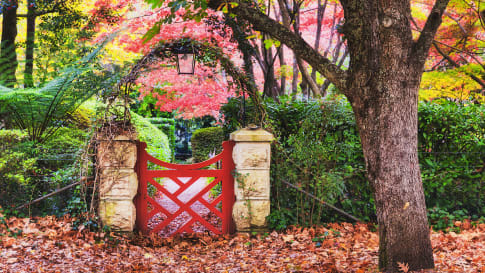
days
AprAutumnal small group tour of the Blue Mountains
Visiting New South Wales
Spend a week in the Blue Mountains outside Sydney exploring the historic homes and gardens of the region over a week. For mature and senior travellers. This small group tour visits 13 very different homes and gardens during the Autumn.

days
Jun, Jul, Sep, Feb, Mar +1Darwin and Kakadu small group tour
Visiting Northern Territory
Explore and learn as part of a small group tour for seniors on this package tour to Darwin and Kakadu National park, a UNESCO world heritage site. This program also visits Arnhem land. Our focus is on ecology, landscapes and history on this 14 day program in the far north of the Northern Territory.
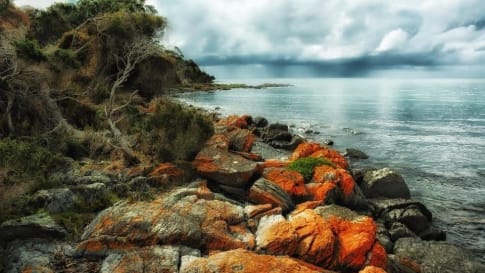
19 days
Mar, Nov, FebDiscovering Tasmania’s Wildlife
Visiting Tasmania
Small group tour of up to 15 mature and seniors travellers visiting and learning about Tasmania's wildlife and history. Visit Maria Island, Freycinet peninsula, Cradle Mountain, Strahan, Lake St Clair and Bruny Island over 16 days.
From A$11,450 AUD
View Tour
days
Nov, Mar, May, Jul, Sep +2Escorted small group tour North East New South Wales
Visiting New South Wales
Small group tour exploring the the North East region of New South Wales for mature and senior travellers. Travel, learn and explore about New England's history, the coast, National parks and regional towns in a time capsule surrounding Mudgee.

14 days
Mar, May, Jun, Jul, Aug +3Escorted small group tour of Western New South Wales
Visiting New South Wales
Discover the the Brewarrina fish traps, Aboriginal art at Mt Grenfell and visit the opal fields of White Cliffs. This small group also visits the World Heritage Site of Mungo man and lady stopping in Mungo National Park and other significant locations such as Broken Hill.
From A$9,250 AUD
View Tour
days
Mar, May, Aug, Sep, Oct +2Small group tour of World Heritage sites and more in the Southern States of Australia
Visiting New South Wales, South Australia
Discover the World Heritage Sites of the southern states of Australia travelling in a small group tour. A journey of learning around the southern edges of the Murray Darling basin and up to the upper southern part of this complex river basin north of Mildura. We start and end in Adelaide, stopping in Broken Hill, Mungo National Park and other significant locations.

days
Apr, Jun, Aug, Nov, Mar +2Exploring Alice Springs and Uluru-Kata Tjuta National park by Motorbike
Visiting
Explore on a Motorbike tour in the Outback and learn about historic Alice Springs, The MacDonnell ranges, and Uluru-Kata Tjuta national park. This escorted small group Motorbike tour for mature and senior travellers, travelling as a couple or solo travellers also visits the Hermannsburg Lutheran mission plus Henbury meteorite site learning about the Aboriginal outback and contemporary art.
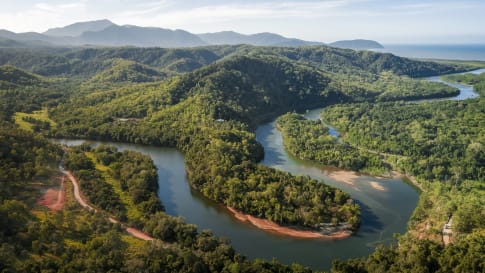
7 days
Sep, Apr, OctExploring the Hawkesbury-Nepean River small group tour
Visiting New South Wales
Explore the Hawkesbury river region with a small group tour for mature and senior travellers, travelling as a couple or solo travellers . Learning about the Aboriginal outback and contemporary art. as you travel up and down and beside the Hawkesbury river.
From A$5,150 AUD
View Tour
15 days
Sep, Dec, Jan, Feb, Mar +2Eyre & Yorke Peninsulas, and the Gawler Ranges
Visiting South Australia
Small group tour South Australia. Yorke, Eyre, and Gawler Ranges, discover the local history.
From A$10,350 AUD
View Tour
days
Feb, Mar, May, Jul, Sep +2Guided small group motorcycle tour of World Heritage sites in Victoria and South Australia
Visiting
Discover the World Heritage Sites of the southern states of Australia travelling in a small group tour of like minded motorcyclists. A journey of learning around the southern edges of the Murray Darling basin and up to the upper southern part of this complex river basin north of Mildura. We start and end in Adelaide, stopping in Broken Hill, Mungo National Park and other significant locations.

days
Mar, Apr, Jun, Jul, Sep +1Guided small group Motorcycle tours of Western New South Wales
Visiting New South Wales
Motorcycle tours of Western New South Wales. Discover the the Brewarrina fish traps, Aboriginal art at Mt Garrett, learn about the opals of White Cliffs. This small group also visits the World Heritage Site of Mungo man and lady stopping in Mungo National Park and other significant locations such as Broken Hill.

days
JanHouses and Gardens of the Blue Mountains small group tour
Visiting New South Wales
Spend a week in the Blue Mountains outside Sydney attending this summer school course exploring the historic homes and gardens of the region over a week. For mature and senior travellers. This small group tour visits 13 very different homes and gardens.
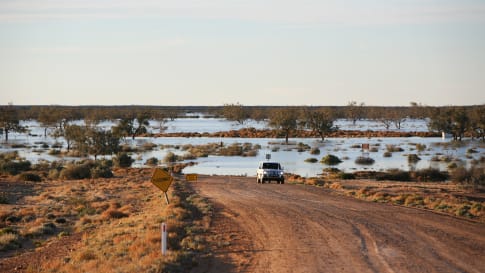
65 days
MarLong tour of Australia for a small group
Visiting New South Wales, Northern Territory
Small group tour for senior couples and solo travellers touring Australia. Travelling through the outback and visiting many of the famous sights as well as off the beaten track locations. Learn about the history of the people who explored the deserts, from indigenous communities to Europeans, as well as Burke and Wills, visit White Cliffs, Marree and far north Kakadu and the Kimberley.
From A$48,995 AUD
View Tour
days
Feb, Mar, Apr, Nov, JanMotorcycle tour of Tasmania for mature riders
Visiting Tasmania
Escorted Small group tour of up to 8 mature and seniors Motorcycle riders visiting and learning about Tasmania's wildlife and history. Visit Maria Island, Freycinet peninsula, Cradle Mountain, Strahan, Lake St Clair and Bruny Island over 14 days.

7 days
Nov, Feb, Mar, Apr, Sep +1Small group tour to Southern Highlands and Canberra
Visiting Australian Capital Territory, New South Wales
Explore and learn on an escorted small group tour of key places to visit in NSW including the Southern Highlands and Canberra. Program for mature and senior travellers limited to 12 people for couples and solo travellers.
From A$3,750 AUD
View Tour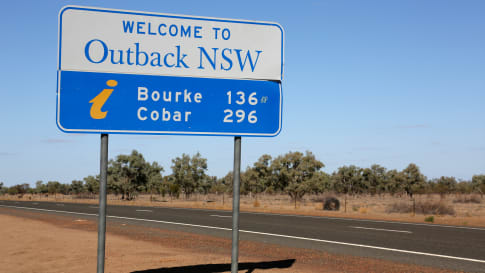
days
Mar, JunSmall group tour of Eastern and Central Australia
Visiting New South Wales, Northern Territory
Small group tour for couples and solo travelers touring most of the Australian territory, travelling through the outback and visiting many of the famous sights as well as off the beaten track locations, giving you the opportunity the explore and meet our people in the most remote locations. Learn about the history of the people who explored the deserts, from indigenous communities to Europeans, as well as Burke and Wills, visit Bourke, Normantown, Charters Towers far north Kakadu, returning back along the Stuart Highway to Adelaide and cross country to Sydney through the Blue Mountains.
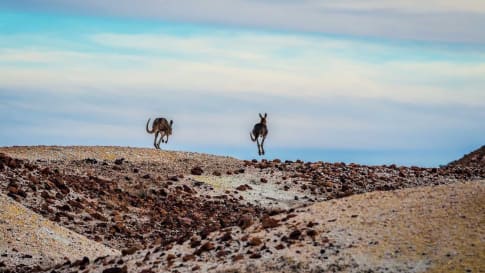
days
Feb, Apr, May, Jun, Jul +3Small group Motorcycle tours; Broken Hill and back
Visiting New South Wales
Small group tour of New South Wales, Queensland & South Australia deserts, from Broken Hill. Learn about the history of the people who explored the deserts, from indigenous communities to Europeans, as well as Burke and Wills, visit White Cliffs, Birdsville, Marree. Explore the outback by motorbike limited to 8 riders.
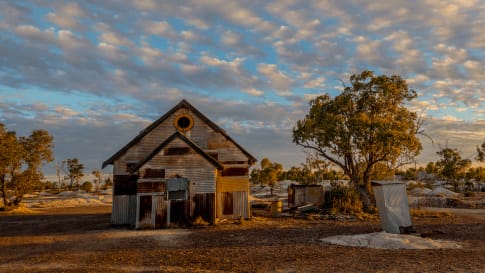
days
Mar, Apr, May, Jul, Aug +2Small group tour of outback Queensland
Visiting New South Wales, Queensland
To Dubbo and back, this small group tour takes you to learn about the Brewarrina fish traps, we travel high up into North Queensland to see the Dinosaurs of Winton and incredible Aboriginal rock art at Cathedral gorge and learn about opal mining and the history of Lightning ridge.

13 days
Mar, OctSmall group tour; Broken Hill and back
Visiting New South Wales, Queensland
Small group tour of New South Wales, Queensland & South Australia deserts, from Broken Hill. Learn about the history of the people who explored the deserts, from indigenous communities to Europeans, as well as Burke and Wills, visit White Cliffs, Birdsville, Maree.
From A$11,550 AUD
View Tour
14 days
Oct, AprThe Darling River Run small group tour
Visiting New South Wales, Victoria
Small group tour for the mature and senior traveller of the Darling River. Learn about the history, culture and landscapes of the Darling, a key part of the Australian river system including Aboriginal trading routes and aquaculture. Suitable for mature and senior couples or solo travellers.
From A$10,750 AUD
View Tour
days
Apr, May, Jun, Jul, Aug +3Small group tour exploring Alice Springs and Uluru-Kata Tjuta National Park
Visiting Northern Territory
Explore and learn about historic Alice Springs, The MacDonnell ranges, and Uluru-Kata Tjuta National Park. This escorted small group tour for mature and senior travellers, travelling as a couple or solo travellers also visits the Hermannsburg Lutheran mission plus Henbury meteorite site learning about the Aboriginal outback and contemporary art.
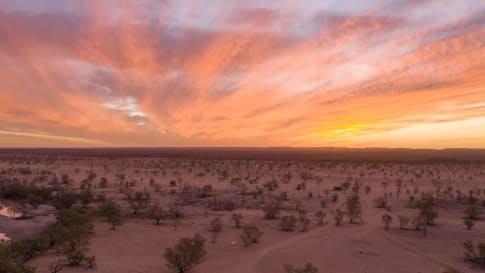
days
May, Jun, Jul, Aug, Sep +2Small group tour of Queensland
Visiting Queensland
On this Queensland Outback small group tour we travel west from Brisbane all the way to Birdsville then continue high up into North Queensland to see the Dinosaurs of Winton and incredible Aboriginal rock art at Cathedral gorge.
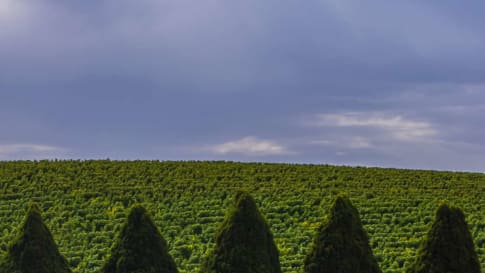
days
May, Aug, Sep, Oct, Nov +3Small group holidays to Adelaide and surrounds
Visiting South Australia
Explore and learn about on a small group tour of Adelaide city and its pastoral, cultural and historic settlement. Visit Fleurieu Peninsula, the Barossa valley, learn about William Morris and the arts and craft movement in the Art gallery and National trust houses.

days
Feb, Mar, Apr, May, Jul +2Small group Motorcycle tour of South Australia
Visiting South Australia
Escorted small group tour for senior motorcycle riders of the Flinders range in South Australia from Adelaide. Learn about Coober Pedy, Wilpena pound and water system of Lake Eyre as we explore and learn also about the history of the people who explored the Flinders.
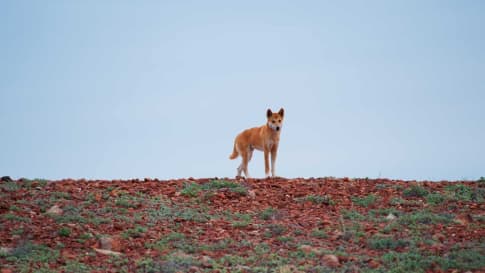
days
Apr, May, Jul, Aug, Oct +2Small group tour of Australia's Flinders ranges
Visiting South Australia
Escorted small group tour of the Flinders range in South Australia from Adelaide. Learn about Coober Pedy, Wilpena pound and water system of Lake Eyre as we explore and learn also about the history of the people who explored the Flinders.

9 days
Mar, Nov, OctSmall group tour of Flinders Island
Visiting Tasmania
Explore and learn about Flinders Island on an escorted small group tour for mature and senior travellers who enjoy a walking holiday. For couples or solo travellers. We also explore Cradle Mountain and Launceston.
From A$6,950 AUD
View Tour
days
Mar, Aug, Sep, Oct, Nov +3Tours of Tasmania; exploring colonial history
Visiting Tasmania
Escorted program for couples and single travellers visiting Hobart, Launceston through the Tamar Valley along the rugged coastline of the north coast and heading back south to the pristine wilderness around Cradle Mountain and then on through Strahan, Queenstown and past Lake St Clair, before arriving back in Hobart. This 18 day small group tours to Tasmania for mature and senior travellers interested in the colonial history of Tasmania. We follow the footsteps of the colonists, visiting the churches where they worshipped, the houses in which they lived, the taverns where they drank and some of the mills in which they worked.
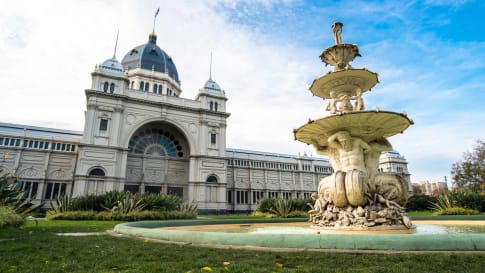
days
Feb, Mar, Apr, May, Aug +3Small group tour of Melbourne
Visiting Victoria
Explore and learn about the Victorian history of Melbourne over a week. For the senior traveller, a small group tour holiday package to Melbourne city, limited to 12 travellers.

days
Mar, May, Aug, Oct, Jan +1Small group tour of Victoria for Senior travellers
Visiting Victoria
This 16 day escorted small group tour of Victoria for the senior or mature traveller who enjoys learning whether as a couple or solo traveller explores an area of central Victoria that is rich in historic houses, gorgeous gardens and some amazing art.

13 days
May, Jun, Jul, Aug, SepSmall group tour of Australia's Kimberley
Visiting Western Australia
Escorted small group tour of the Kimberley. We explore and visit The Bungles, Bell Gorge, Mitchell plateau & Halls Creek in the dry season. Amazing landscapes intertwined with Aboriginal communities resident more than 45,000 years.
From A$15,390 AUD
View Tour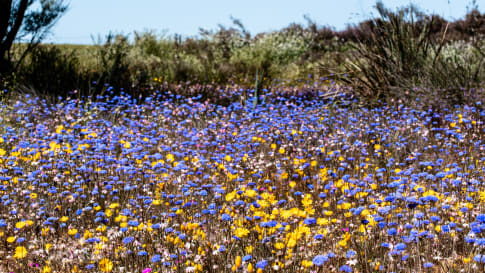
15 days
Aug, SepWildflowers tour of Western Australia
Visiting Western Australia
Escorted small group tour for senior and mature travellers as a couple of solo traveller. Upto 12 people of WA's Wildflower regions including Esperance and the Fitzgerald river National park. Local guides and program leader share knowledge about this fascinating region whilst in bloom.
From A$12,250 AUD
View TourMammals
Kangaroo
When it comes to Australia‘s wildlife, the first thing most people think of is the iconic Kangaroo. In Australia there are 6 main species the term ‘Kangaroo‘ encapsulates, ranging from the smaller wallaroo, to more familiar species such as the eastern grey kangaroo, or the large and powerful red kangaroo. Kangaroo‘s most distinctive feature is their unique method of locomotion, namely hopping forward on its two strong hind legs, some species can even reach speeds of 55km (34mph) per hour, and clear distances of up to 13m (43ft) in a single bound. Generally kangaroos are docile and passive creatures, relying on a diet of grasses and other small plants, and pose no threat to humans, though they have been known to defend themselves from hunters and dogs in the past. Today there are over 50 million kangaroos in Australia, twice as many as the country’s human population! With the number projected to increase further with each passing year.
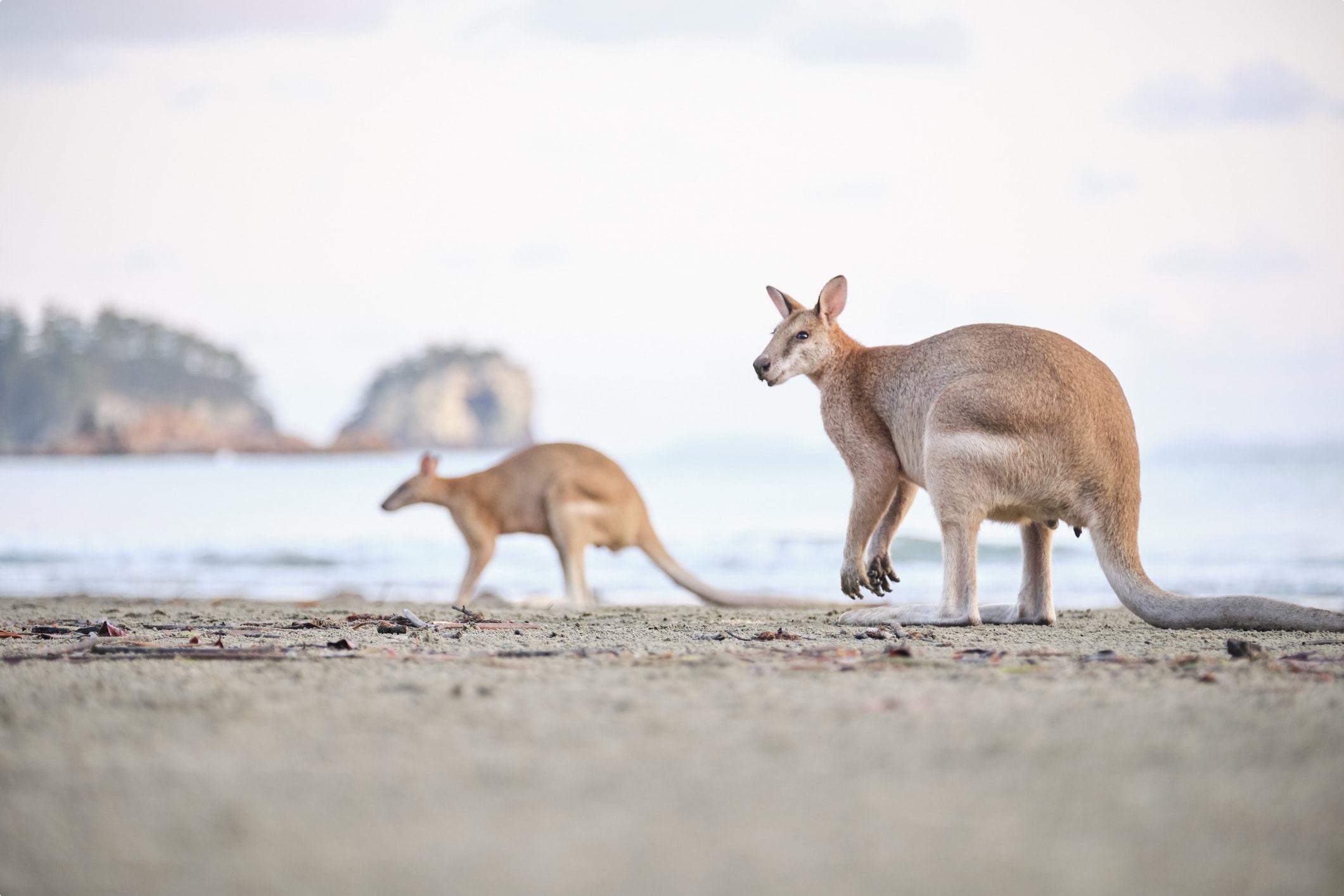
Wallaby
The Kangaroo‘s smaller relative, the wallaby is similar in appearance and demeanor to its larger cousin, with very few real differences between the species, save for the larger size that characterizes the kangaroo. Wallabies are also herbivorous and generally passive creatures, though in contrast to some of the large kangaroos, they can be found in a larger variety of habitats. The rock wallaby is one such example of this kind of animal, living in colonies centered around sheltered rocky outcrops. The yellow-footed rock wallaby in particular is renown for its incredible fur pattern, and can be found throughout Australia‘s Flinders Ranges region.
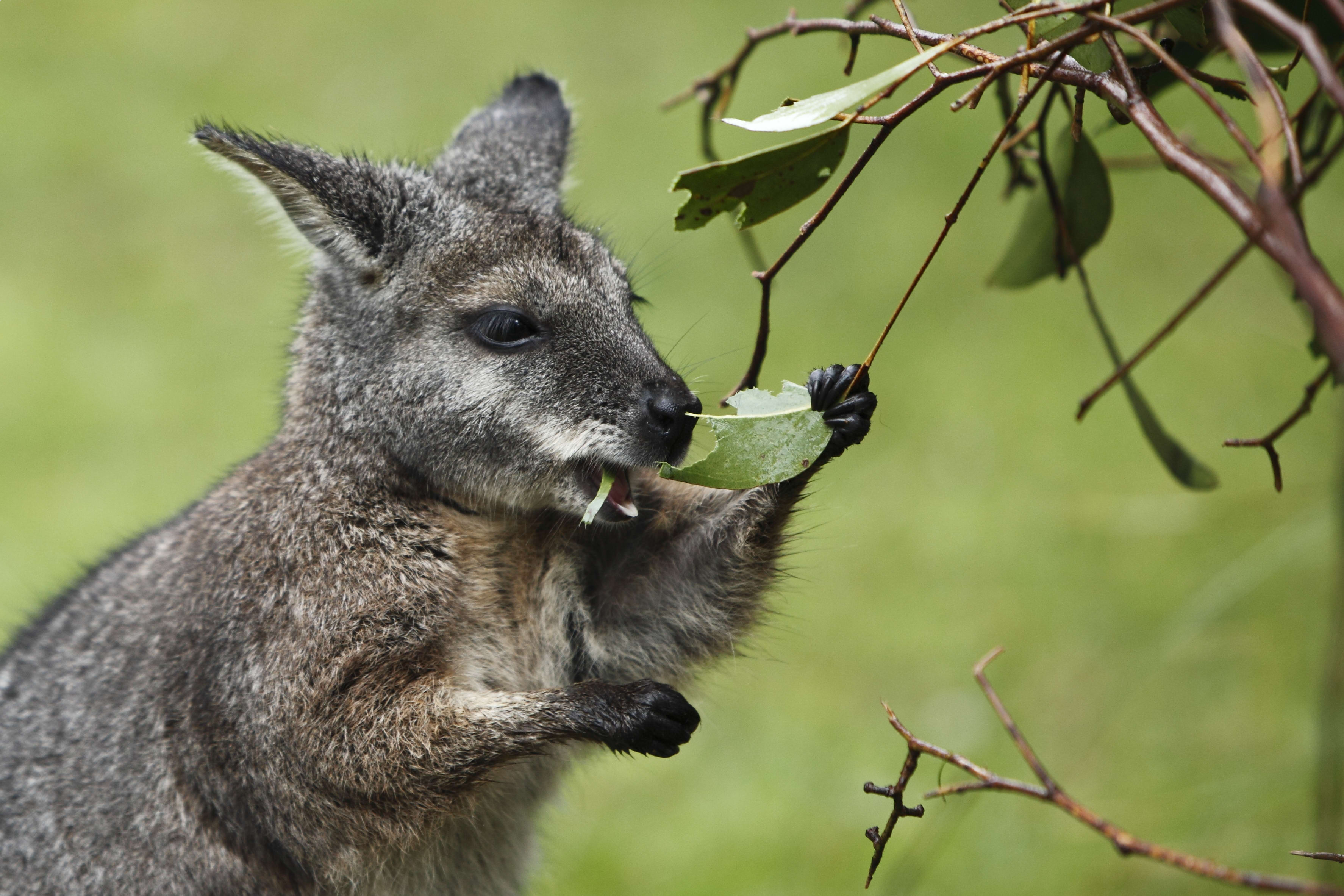
Koala
Another of Australia‘s more iconic marsupials, the Koala is found all along Australia‘s eastern coast, and is known for its small size, sleepiness, and overall cuddly appearance. The koala‘s name is said to have originally come from the indigenous word ‘gula’ meaning ‘no water’, this is due to the fact that koalas are rarely seen coming down from the treetops, so it was thought that they derived all their water needs from the leaves of the eucalyptus tree. Though this has subsequently been proven as a myth, the specificity of the diet certainly isn’t, eating almost exclusively the leaves of the eucalyptus tree. Though the makes the koala a specialist eater in some regards, there are over 600 species of eucalyptus in Australia, around 30 of which koalas show a particular preference for, due to the higher protein content in these species. Despite this, a koala‘s diet is still overall very low in nutrition, which is why most koalas will spend upwards of 20 hours a day napping, bear in mind this is how you will likely find them on a visit to a zoo or wildlife sanctuary.
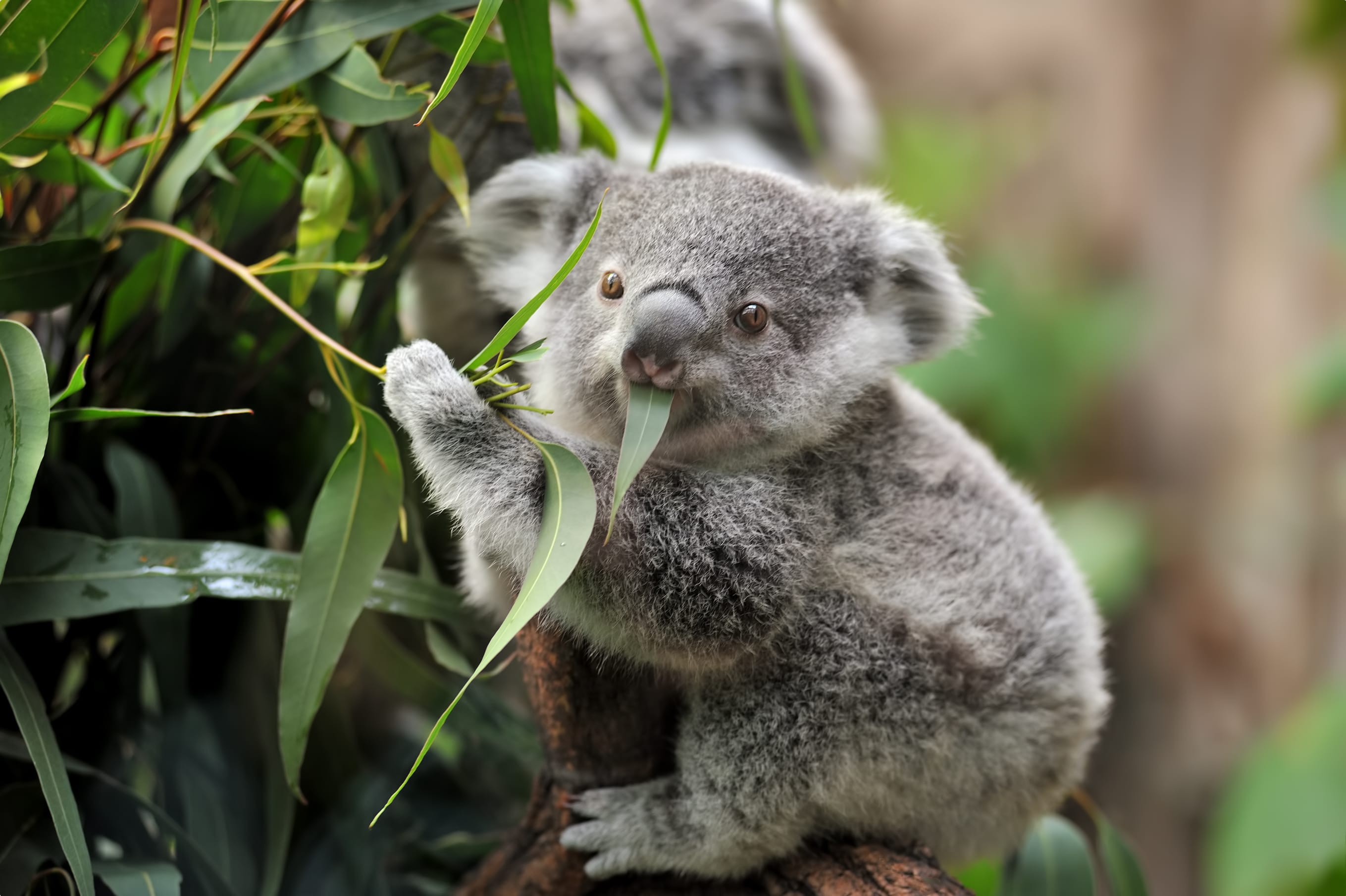
Tasmanian Devil
Native to the small island of Tasmania off Australia southern coastline, the Tasmanian Devil is a small carnivorous marsupial known for its ferocity, and clever opportunistic scavenging behaviour. Overall they are rather diminutive in size, reaching up to 65cm in length, though they are still rather powerful predators, with one of the most powerful bites for its size of any mammal on earth. In the wild, Tasmanian devils are generally solitary creatures, though they can come together in groups to scavenge, or during breeding season. Currently the ‘Tassie devil’, is threatened from both human activity, as well as a virus that has been reducing the population, though attempts have been made to conserve the iconic animal, including the introduction of a New South Wales colony.
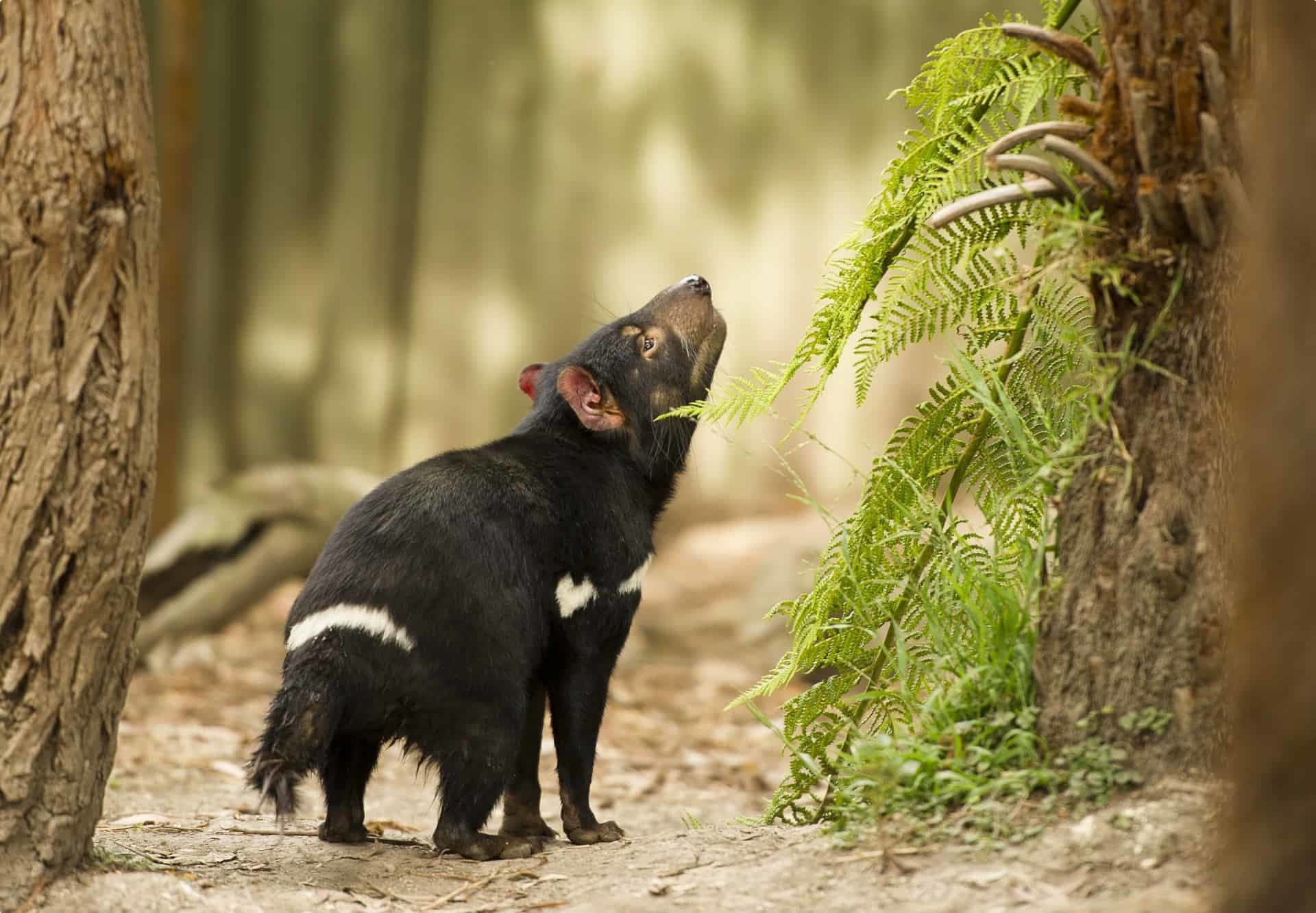
Wombat
Found across southern, and eastern Australia, as well as across the island of Tasmania, the wombat is a small, rotund burrowing marsupial. Measuring about a meter in length, and weighing in at about 20 or 30kg, the wombat is a herbivorous creature, often living in deep burrows, and coming out in search of grazing in the twilight, or evening hours. Though they are generally seen pottering around slowly and leisurely, wombats can in fact move incredibly fast when they need to, reaching speeds of up to 40km per hour when threatened or on the run. When hiding from predators like dogs or Tasmanian devils, they are known to delve head first into their burrows, leaving their thick bony backside exposed to the confounded predator, while they kick them away with their strong hind paws.
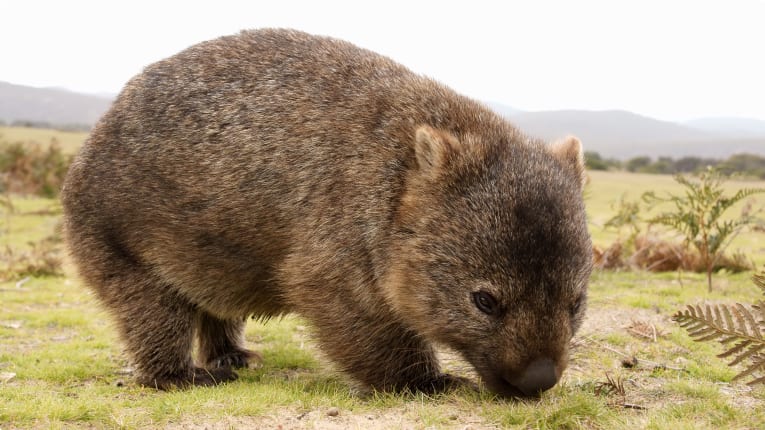
Quokka
Found on a number of islands off the coast of Western Australia, the quokka is famous as one of the world’s most photogenic creatures. At just the size of a small domestic house cat, the quokka is actually among the smallest kinds of kangaroo. They are generally extremely calm, friendly, and unafraid of humans, or many potential predators, and feed on a diet of grasses, shrubs, and other vegetation. With the introduction of non-native predators such as foxes and cats, much of the mainland Australia quokka population was drastically reduced, with only a few protected pockets remaining. Despite this, the quokka is plentiful on islands off the coast, such as Rottnest Island, where they are a major draw for tourists in the region.
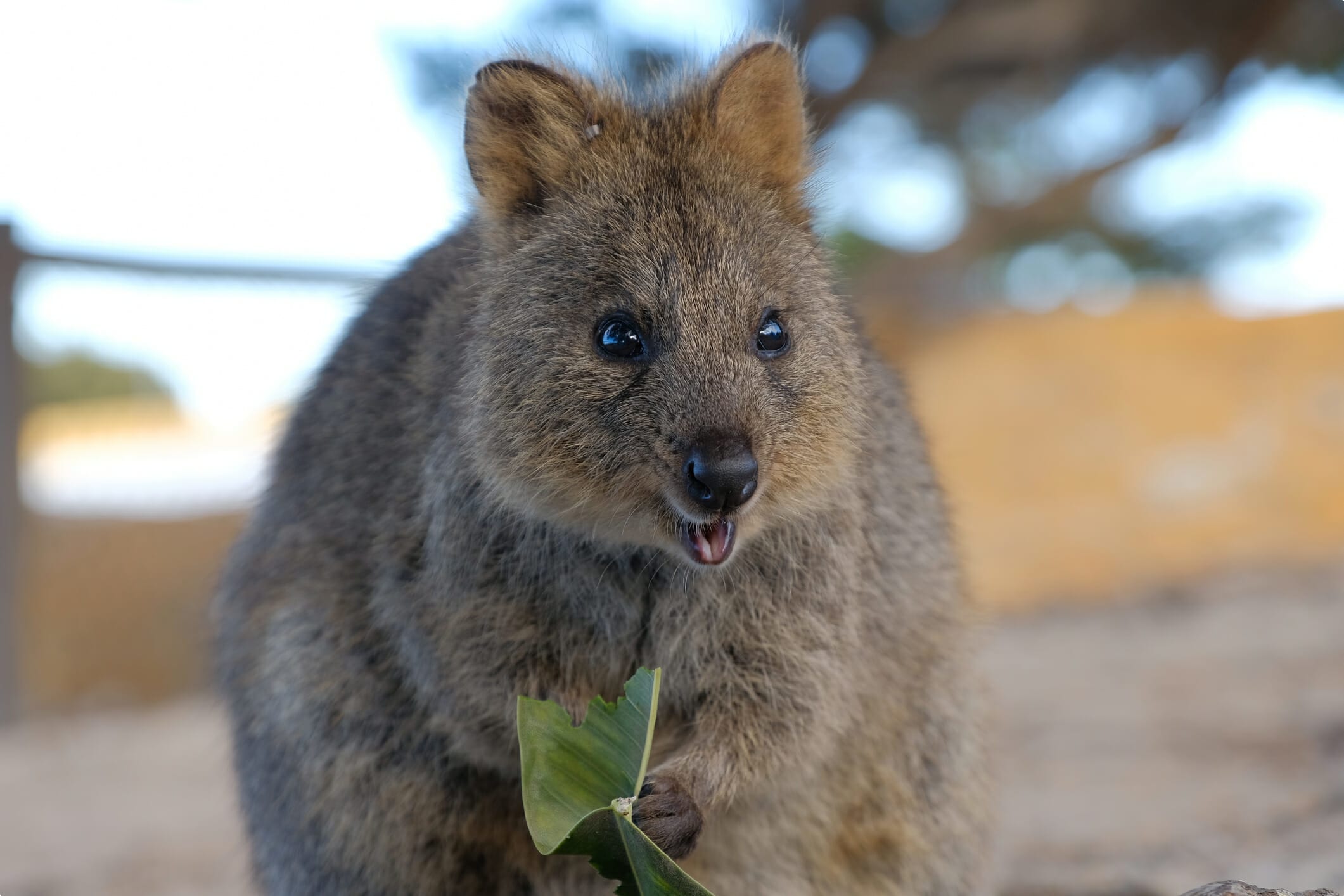
Numbat
Found in a number of protected areas in Western Australia, as well as some newly introduced areas in South Australia and New South Wales, the numbat is a curious marsupial, with an insectivorous diet, and long sticky tongue, much like an anteater or aardvark. At around 40cm long, the numbat is quite a small marsupial, with a characteristic black and brown striped fur and a long bushy tail, it also has a full set of non functional teeth, which it never requires due to its diet consisting entirely of termites. Despite once being widespread across western and south Australia, the numbat is only found in a number of small protected areas today, being unaccustomed to the influx of new predators brought to Australia by humans.
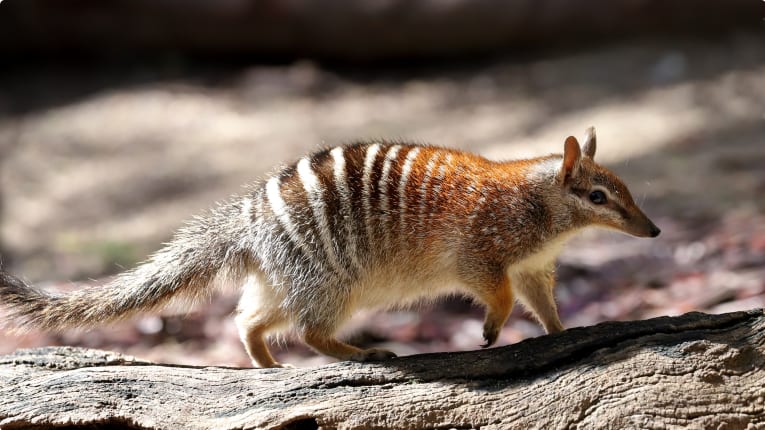
Bilby
Once found throughout about 70% of Australia, the Bilby is now known as one of Australia‘s rare desert dwelling marsupials. Found today in places such as the Kimberley, Pilbara, as well as the Tanami, Gibson, and Great Sandy Deserts the Bilby is nocturnal omnivore, emerging from its burrows to hunt grubs, insects, and eat seeds or grasses. With an incredible sense of smell and hearing, the bilby does not rely on sight to hunt, and is able to sense prey burrowed deep beneath the sand below. Its nocturnal hunting also serves the added benefit of removing the need for the bilby to find water, gathering all of the moisture it requires from hunting small prey beneath the desert floor. Today many Australian’s will recognise the bilby as the country’s unofficial replacement of the eastern bunny, with the campaign aimed at raising funds and awareness for the bilby’s conservation efforts.
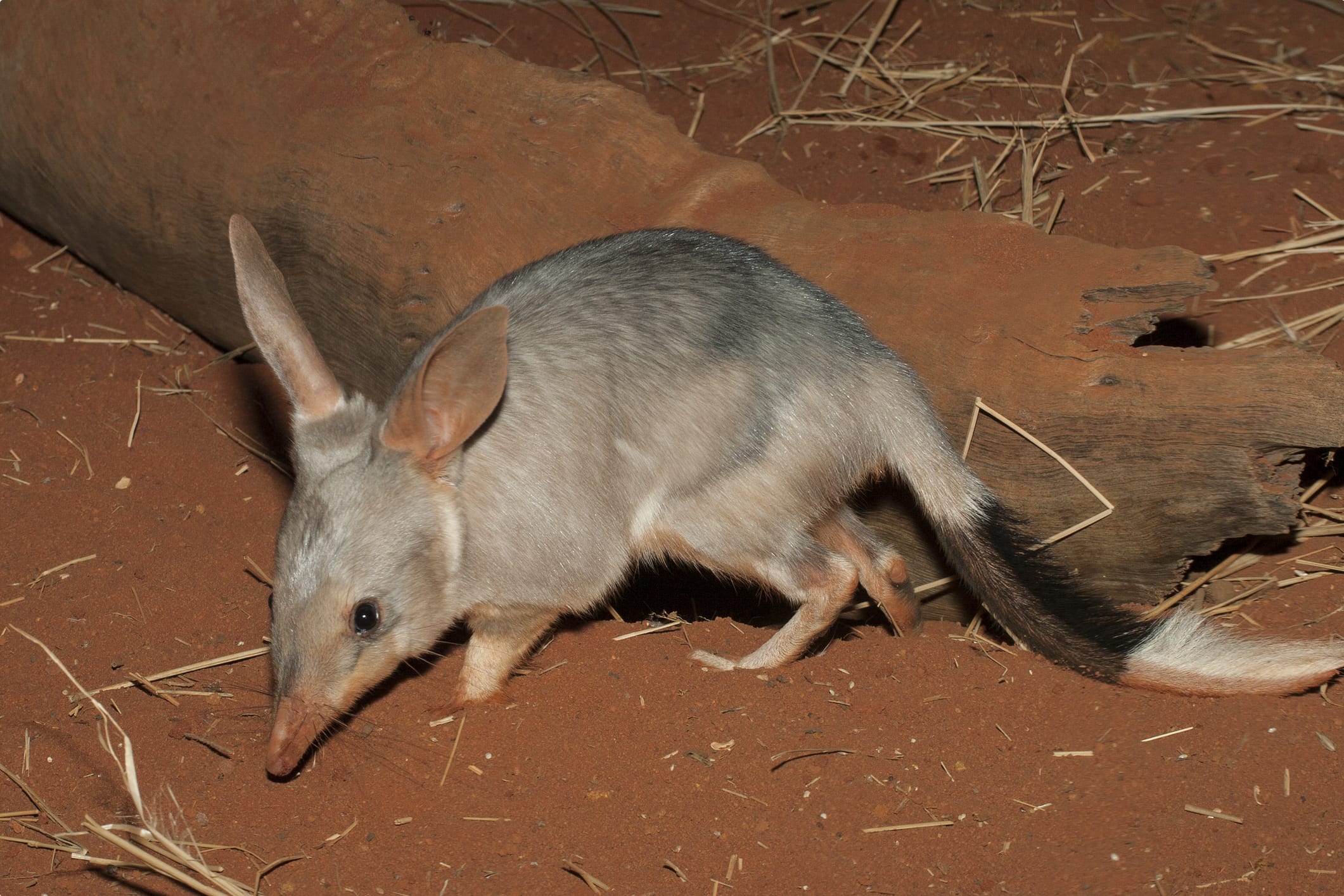
Sugar Glider
Found across northern, and eastern Australia all the way down to the island of Tasmania, the sugar glider is another of Australia‘s smaller marsupial variety. The sugar glider gets its name for its known predilection for sweet foods such as nectar, sap, or honey, as well as its ability to glide between trees, with large flaps of skin serving the function of basic wings. The sugar glider is a small creature, at just 30cm long, and incredibly light at just over 100 grams, which no doubt aids it in soaring effortlessly between trees, they also have strong hind paws with an opposable thumb, allowing them to grasp branches and bark to stay firmly attached to the trees high above the canopy. In more recent years sugar gliders have grown in popularity throughout the world as exotic pets, with some having originated from Australia, and others from New Guinea. Currently depending on the state, the legality of keeping one of these native marsupials varies, with notably the large states of New South Wales and Queensland banning the practice.
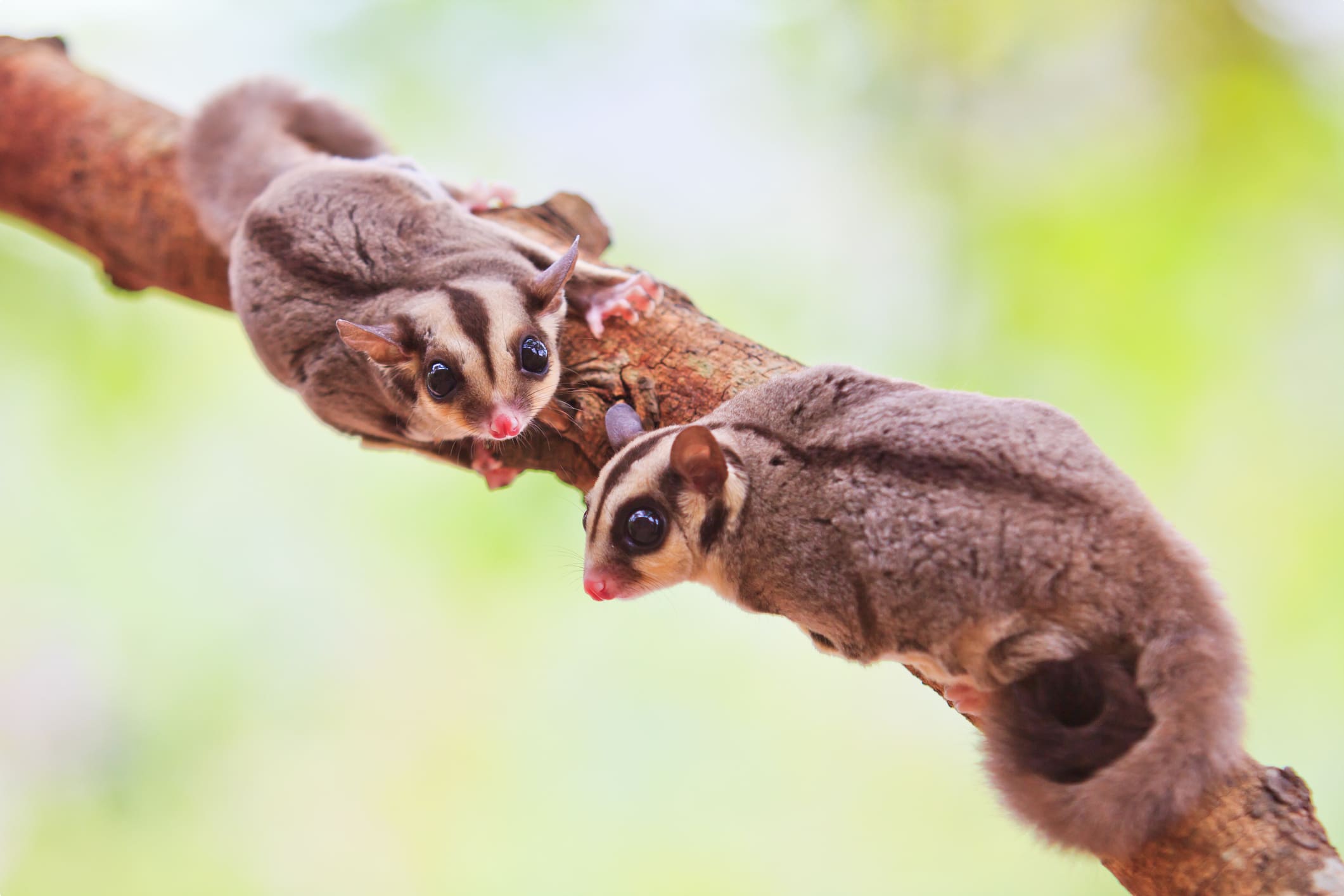
Dingo
The dingo occupies something of a different position on this list, with the canine itself not actually being a native Australian species, despite what many Australians may think. For the unfamiliar, the dingo is a medium sized canine resembling something akin to a domestic dog, generally with a light ginger, tan, or dark coat of short fur. It is theorized that the dingo was actually brought over to Australia from southeast Asia some time around 8000 years ago, bearing a relatively close relation to ancient varieties of dogs found across New Guinea. Some have even attributed the arrival of the dingo to mainland Australia as one of the possible causes, if not certainly a contributing factor to the extinction of Australian animals such as the thylacine (Tasmanian Tiger) on the Australian mainland.
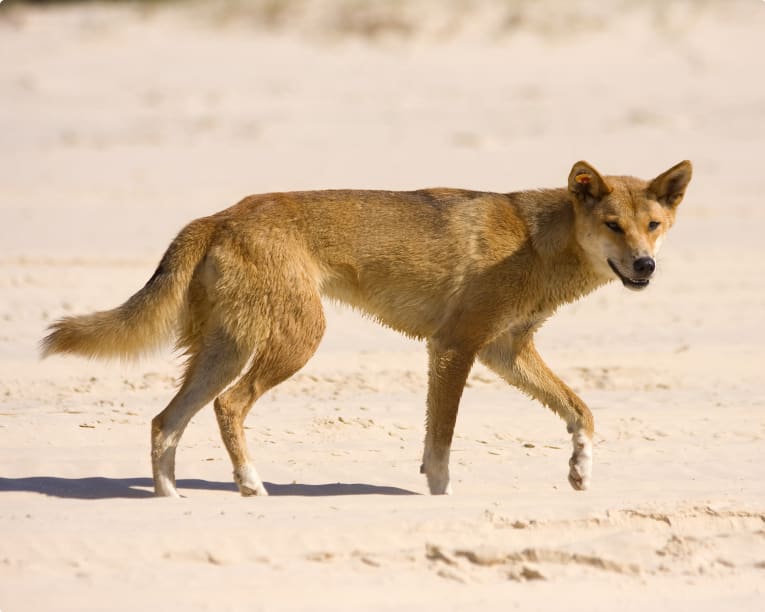
Birds
Emu
One of the two iconic animals on Australia‘s coat of arms, the emu is one of the better known amongst Australia‘s native bird life. Found across Australia, the emu is the second largest bird in the world, second only to its African relative the ostrich. The emu sports a thick, shaggy brown coat of feathers, with a long neck, and thick scaly legs, and can often been found preening or grazing across Australia‘s vast bushland. Emu’s generally lead a solitary existence, though they come together during the breeding season, after which the father takes responsibility for the young until they are mature enough to fend for themselves. A strange fact pertaining to both the emu and kangaroo is that they are incapable of walking backwards, a fact which ties in with the narrative of coat of arms, with Australia never taking a step back. Fortunately the emu continues to remain stable across much of Australia, and is of least concern when compared to other Australian natives. To the amusement of many, Australia even once fought a war against its Emus in a someone comical event known as the ‘Emu War‘.
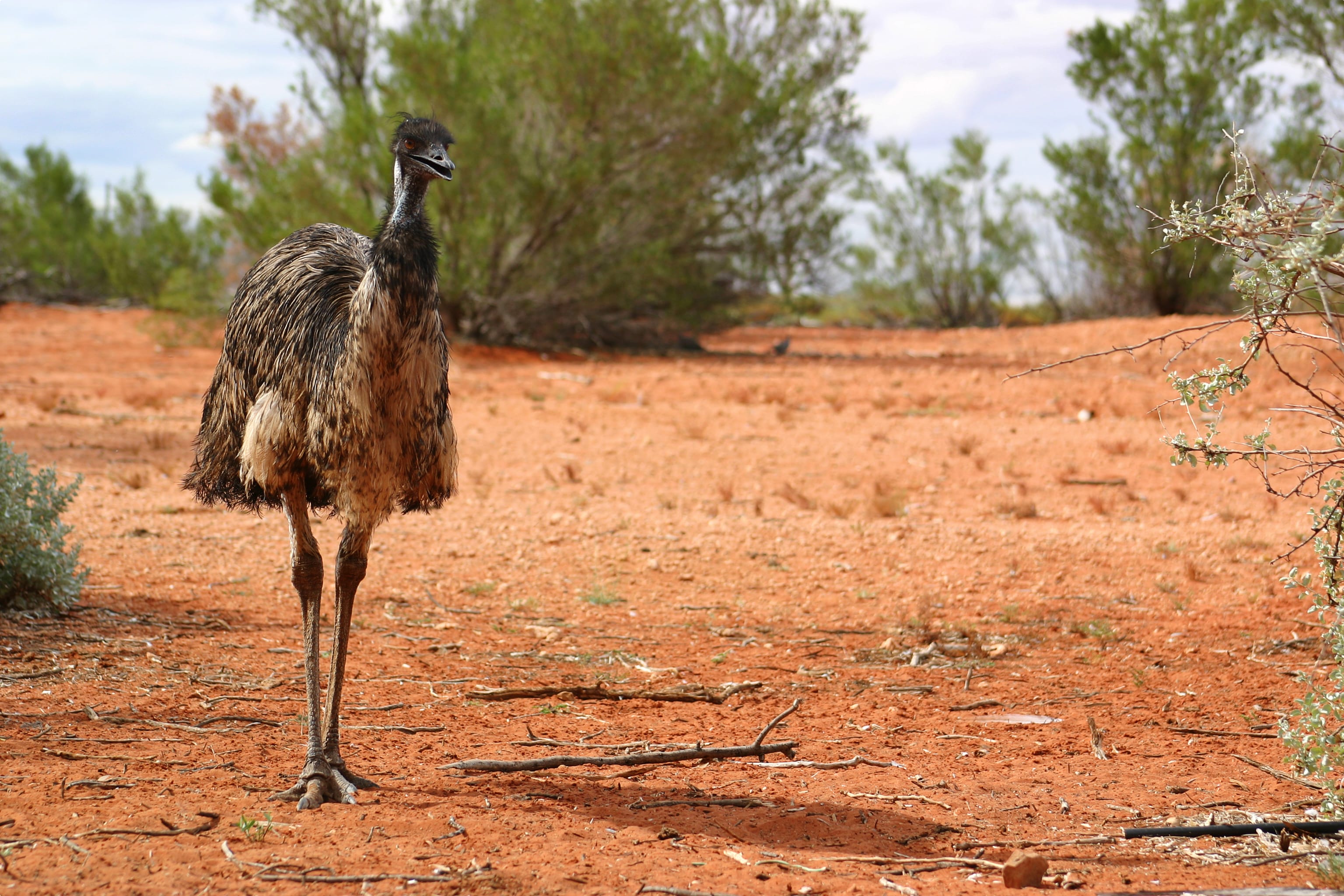
Kookaburra
The subject of songs and folklore, the kookaburra is an iconic Australian bird, known best for its loud and lengthy call, sounding much like a long cacophonous laugh, of which the name ‘kookaburra’ is an onomatopoeia. Belonging to the kingfisher group of birds, the kookaburra is distinct in that its diet largely precludes fish entirely, not only that, but the species association with water is mostly absent. Australia‘s kookaburra has instead come to live more like a bird of prey, eating small mammals, lizards, insects, and even other birds young at times. There is also a northern variety of kookaburra which features vibrant blue wingtips and tail, despite the seeming relation, the two are known to actively compete for territory, suggesting a divergence some time ago. Today you are likely to see kookaburras across Australia, including in its larger cities’ parks and suburbs.

Southern Cassowary
Sporting a vibrant colourful head, an enormous bony crest, and long thick scaled legs, the cassowary is an incredible bird, resembling something from an earlier era of time rather than most birds we expect to see today. Native to north-east Queensland and parts of New Guinea, the cassowary is one of the largest birds on earth, at a similar height to the emu, as well as being the second heaviest bird after the African ostrich. The cassowary has something of an unearned reputation when it comes to human interaction, with reports of attacks and violence causing many to fear the birds. In practice the majority of the time this has been attributed to humans interacting and feeding the birds, which then grow accustomed to feeding and chase people for more. It is thought that the cassowary is actually quite closely related with New Zealand’s iconic kiwi, with the two having split from a common ancestor some 40 million years ago.

Cockatoo
Across Australia there are a huge variety of cockatoos, ranging from the exotic great black cockatoo, to more common sights such as the galah, or sulphur-crested cockatoo. Characterised by their raised crests and curved bills, cockatoos are some of the world’s most intelligent birds, being capable of incredible feats of cunning as well as mischief. The sulphur-crested cockatoo in particular is one of the most likely birds you’ll see on a tour of Australia, with a distribution across the north, and eastern coasts of Australia, and doing particularly well in city environments. They are quite large for parrots, reaching about 55 cm in length, with a large distinctive yellow crest atop their stark white body, they are also known to make an incredibly loud raucous call, which can be heard from a long distance.
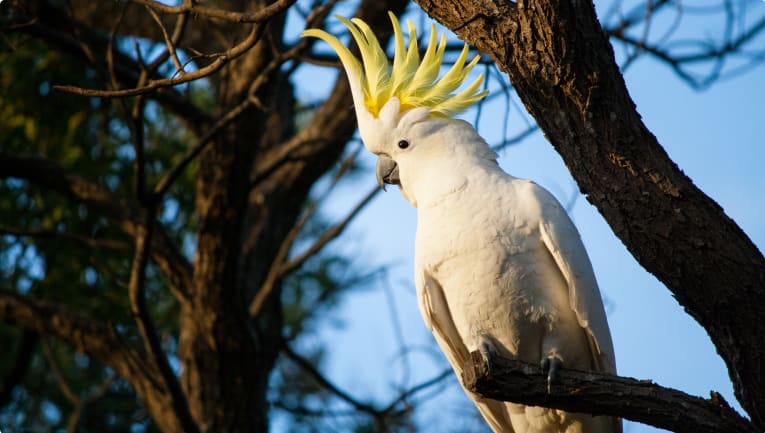
Wedge-tailed Eagle
Found throughout Australia, including Tasmania, the wedge-tailed eagle is the continent’s largest bird of prey, with a wingspan up to 2.8 metres and body length over a metre, the wedge-tailed eagle is one of Australia‘s few apex predators. With a sharp hooked beak, and covered in thick brown and black feathers, the eagle is a distinctive sight, often spied in rural Australia scavenging road kill or soaring high overhead surveying the landscape. Like many other large birds of prey, the wedge-tailed eagle relies on its sense of sight to hunt, being able to pinpoint small movements from an incredible distance, as well as see in the ultraviolet spectrum. Generally these eagles will hunt prey such as small kangaroos, possums, wombats, and other birds, and at times they’ve even been known to even take down emus, particularly juveniles. In contemporary Australian culture the wedge-tailed eagle is used prominently on the symbols for the Australian Defence force, as well as the Royal Australian Air Force, and New South Wales Police.
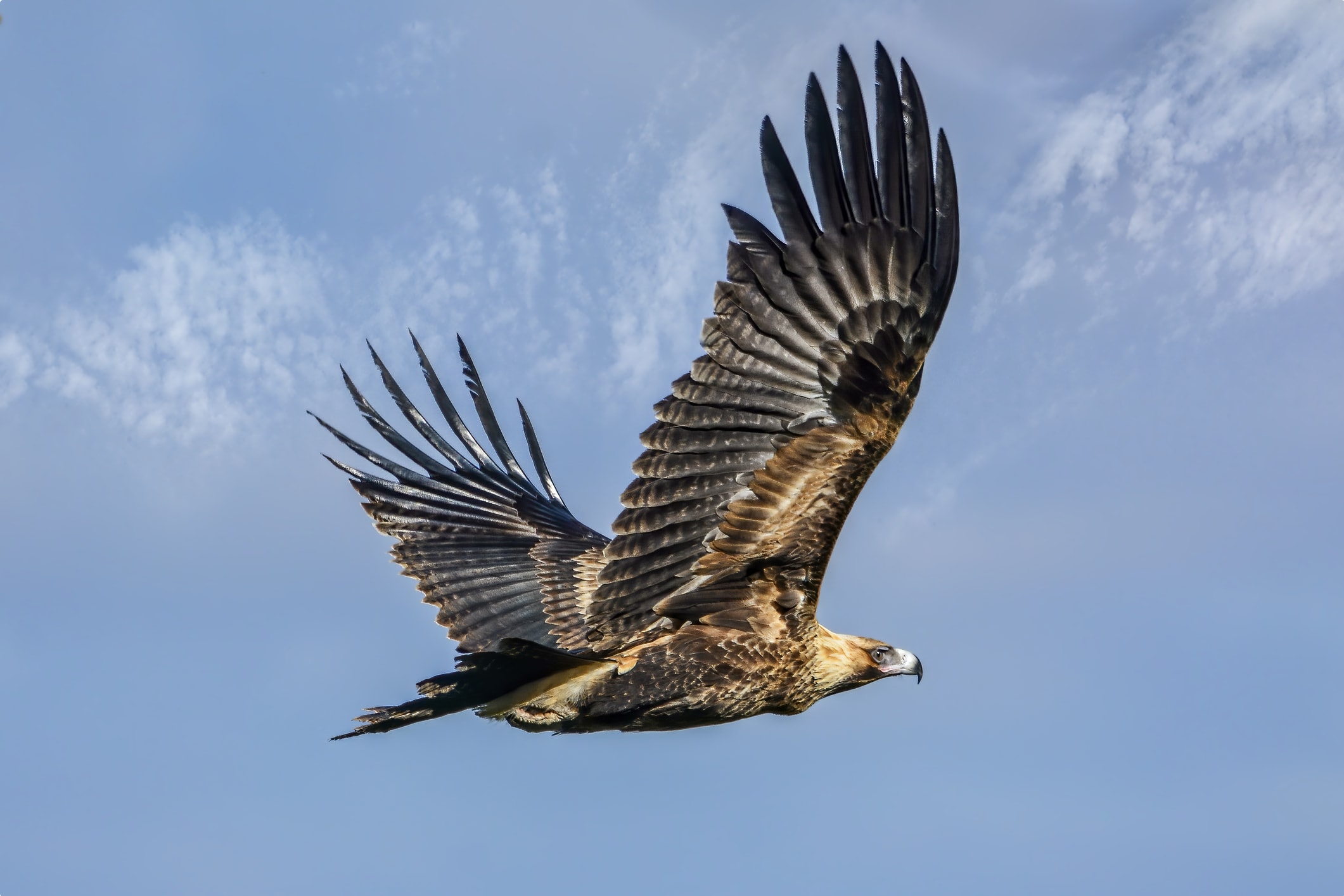
Reptiles
Saltwater Crocodile
Found across Australia‘s northern coastal regions, the saltwater crocodile, or ‘saltie’ for short, is the largest of the world’s crocodiles, its evolutionary design much the same as it was 65 million years ago. Measuring around 6m in length, and weighing about a tonne, the saltwater crocodile is the apex predator of Australia‘s northern aquatic habitats, hunting with ambush tactics, and sporting the second strongest bite force of any animal on earth. What distinguishes the saltwater crocodile from many other species is its tendency to swim out into the open ocean, often riding currents long distances in search of new territory to claim. From here many follow rivers further inland, spreading far and wide across Australia‘s northern reaches. The saltwater crocodile is an opportunistic hunter, with its diet mostly consisting of whatever is available in the local environment, whether that be fish, birds, or even larger mammals like water buffalo. The ‘Saltie’ was once endangered across Australia following a culling program of the reptile back in the 1970s, fortunately since then the populations have mostly recovered, with Australia‘s crocodile population being amongst the healthiest.
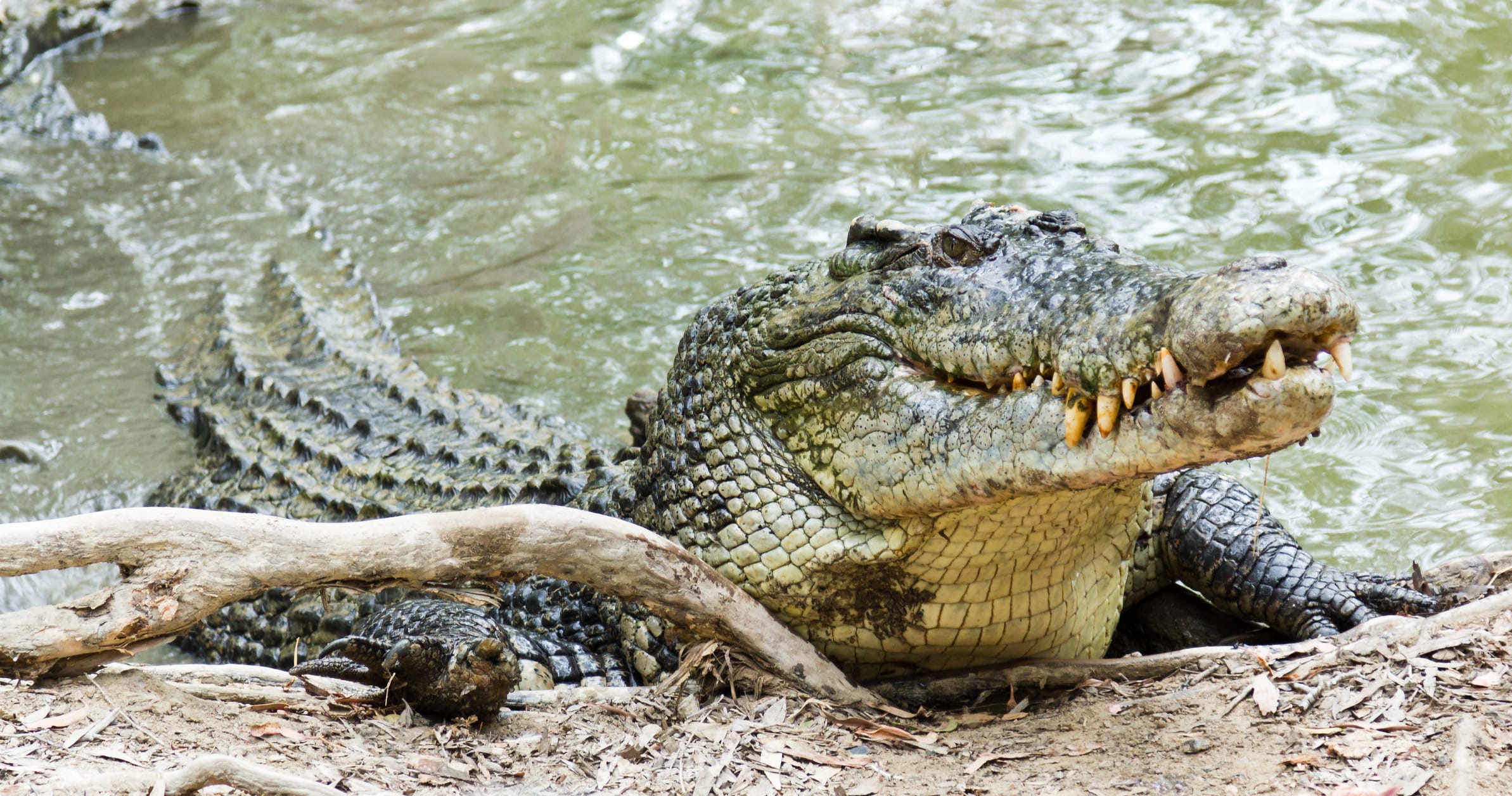
Goanna
Another of Australia‘s strange fauna, the goanna is a type of monitor lizard found everywhere throughout Australia, with the only exception being Tasmania. Depending on the environment, there are a huge varieties of Goanna you can find on a tour of Australia, with some of the largest reaching up to 2.5 meters, and the smallest at less than 70cm. Goanna’s are a carnivorous reptile, with rows of small sharp teeth and the ability to run quite quickly on the hind legs to close the distance with prey, or to flee from nearby threats. In the time of Australia‘s megafauna, the Goanna’s ancestor was one of Australia‘s apex predators, with the 7m long megalania found in Australia as recently as 50,000 years ago. The word ‘goanna’ is thought to be a derivative of ‘iguana’, brought by western settlers who had no conception of what exactly the monitor lizard was.
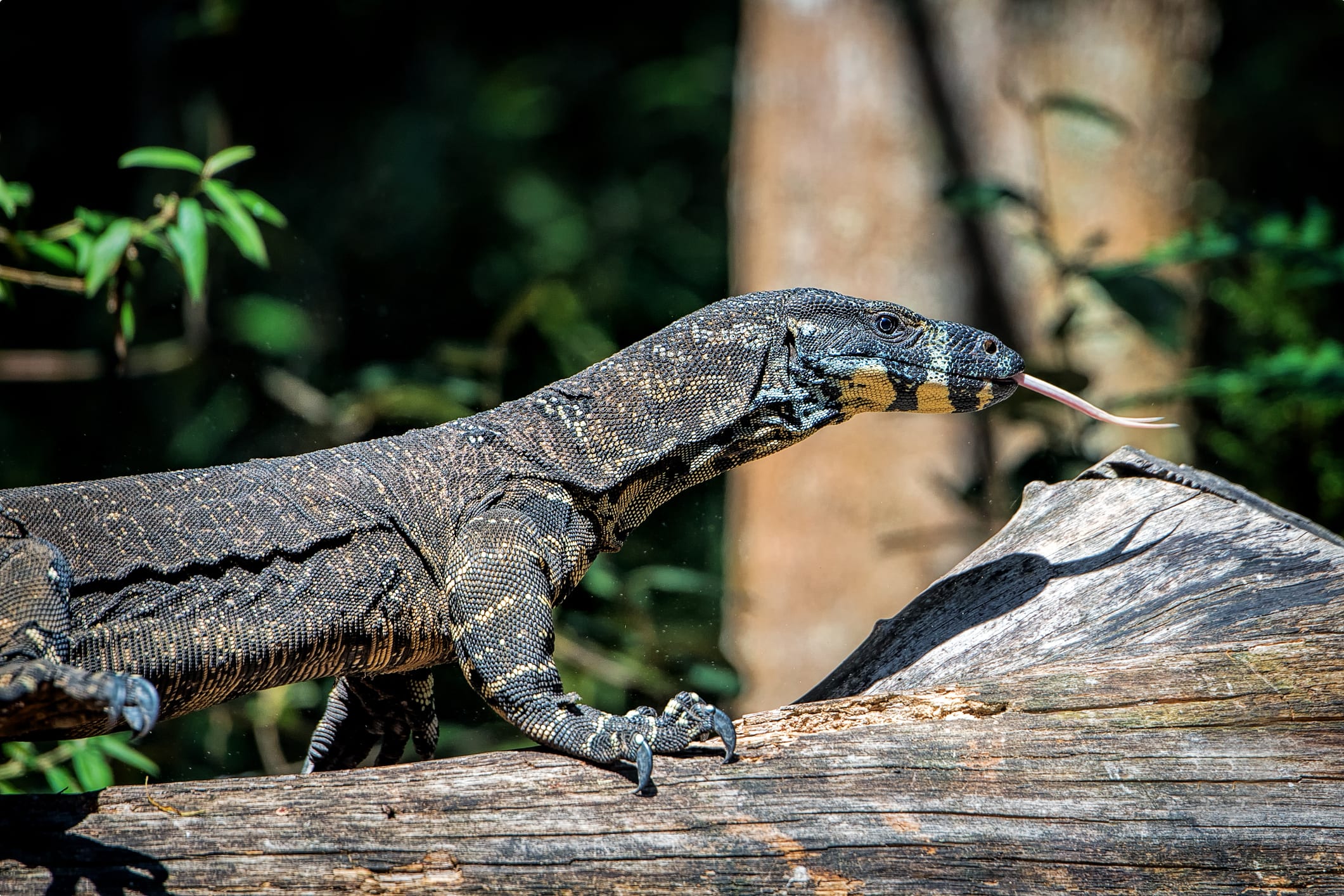
Frill-Necked Lizard
Otherwise known as the ‘Frilled Dragon’ or Chlamydosaurus, this lizard is found across Queensland, the Northern Territory, as well as throughout the Kimberley region. The lizard is quite large, measuring up to 85cm, and can generally be found in trees, hunting for insects of small invertebrates. It gets its unique name from its characteristic frill, which it can extend into a huge disk to intimidate predators, often times rearing up on its hind legs and opening its jaws to enhance this bewildering spectacle.
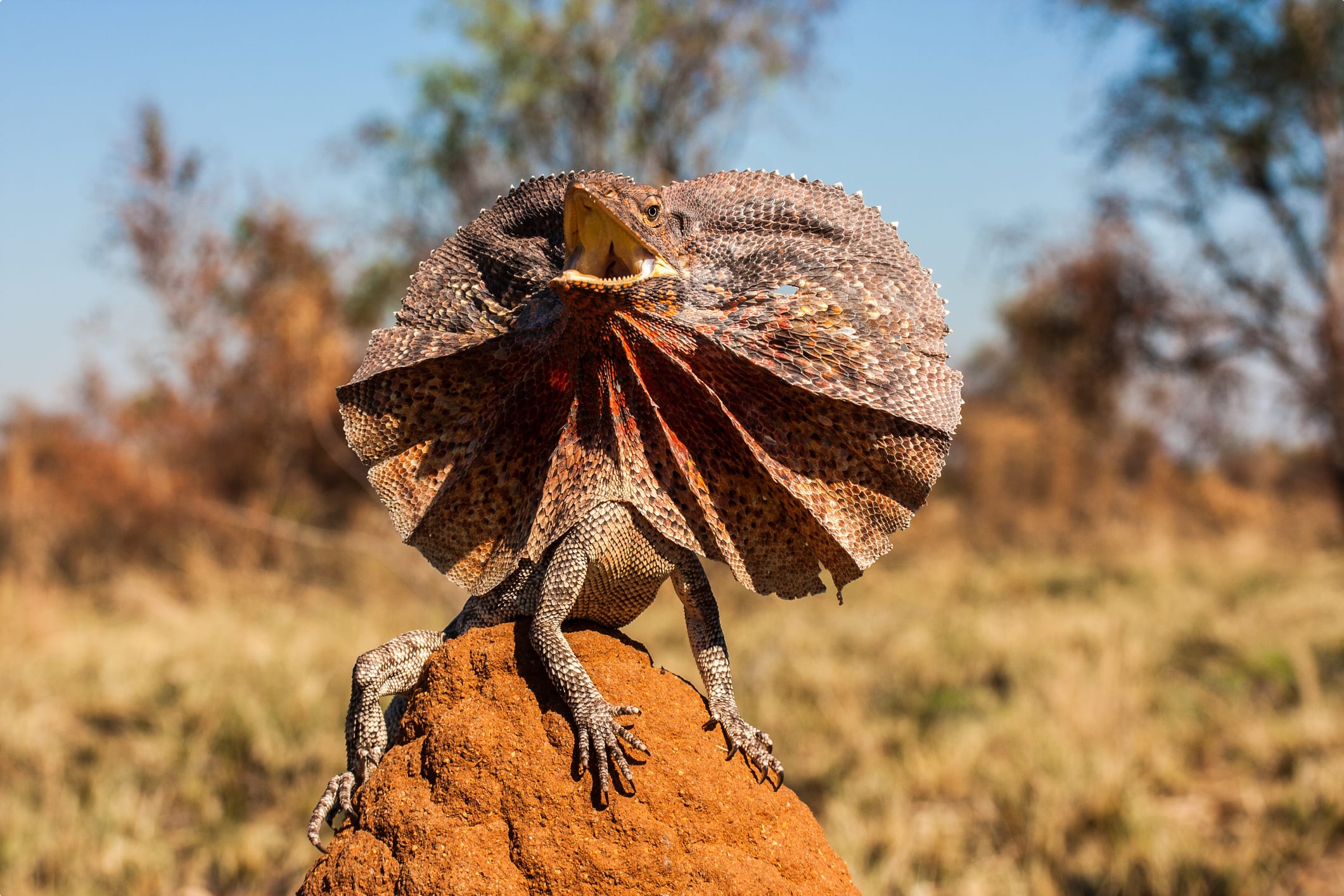
Thorny Devil
Another strange and unique Aussie native, the thorny devil can be found throughout Australia‘s central and western deserts. Only a small lizard at about 20cm, the thorny devil makes up for its small size with its panoply of bizarre talents. Starting with its appearance, the devil is covered in spiky extrusions and spines all over its body, making it a difficult, and dangerous meal for any prospective predators. Add to this the fact that it has a fake ‘second head’ on the back of its neck, it makes it appear to observers like its always watching, and just in case this isn’t enough, the devil can camouflage itself with changing skin colour to blend in with the desert’s sands, and scrubland. The thorny devil gets most of its water through the deserts humidity, with its spines collecting moisture from the air and channeling it to the lizards mouth.
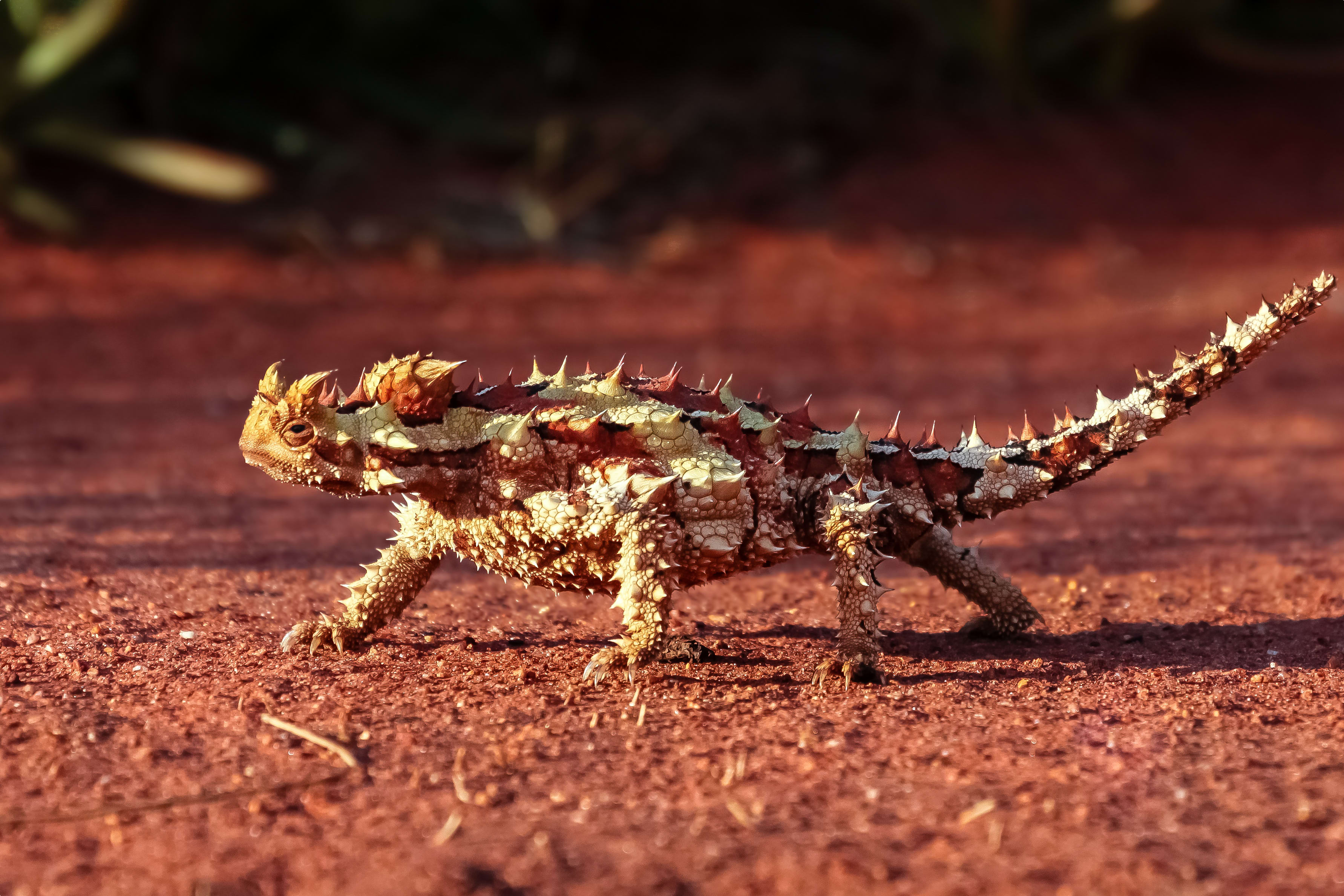
Snakes
Of all Australia‘s wildlife, snakes probably have the most infamous reputation, with several Australian snakes ranking amongst the deadliest, and even the most deadly in the world. However, this reputation is mostly undeserved, with death by snakebite being an incredibly rare occurrence, in fact, you’re more likely to die from horse or cow than these ‘deadly’ serpents. With over 170 species across the continent, Australia is full of snakes, with some of the more common such as the carpet python, green tree snake, or eastern brown snake, often being found close to, or in some of Australia‘s urban environments. Contrary to popular opinion, these snakes are rarely aggressive, and are far more likely to flee than attack. To see some of these up close, zoos and reptile parks across Australia area great way to see some of these iconic Aussie serpents up close.
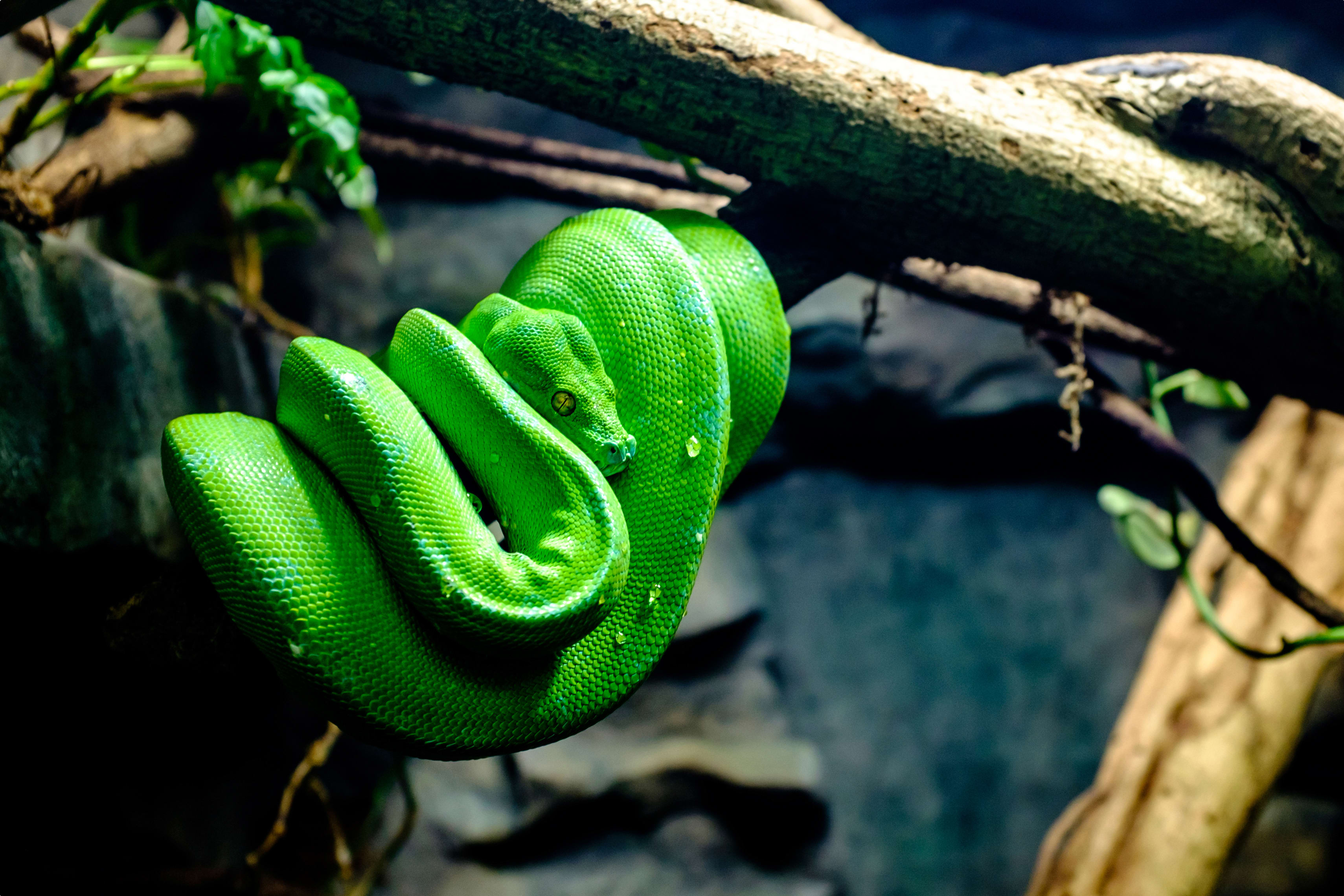
Monotremes
Platypus
The Platypus is definitely among the weird and the wonderful when it comes to Australia‘s native wildlife, being one of the world’s two ‘Monotremes‘ a peculiar type of mammal which both lays eggs, and feeds milk to its young, as well as sporting a number of physiological differences with all other kinds of mammals. The platypus in particular confounded naturalists when it was first encountered by Europeans, convinced the animal could not be real, with its features resembling an odd mesh of duck, otter and beaver all thrown together. As Australian’s now know though, the platypus is simply a strange an incredible animal, with its bill able to sense its prey underwater through echolocation much like a dolphin, its soft fur providing insulation, and the males even having a venomous spur for defence on their hind limbs. The platypus can be found across the eastern extent of Australia, inhabiting ponds, creeks and other waterways, where it feeds on worms, insect larvae, and freshwater shellfish.
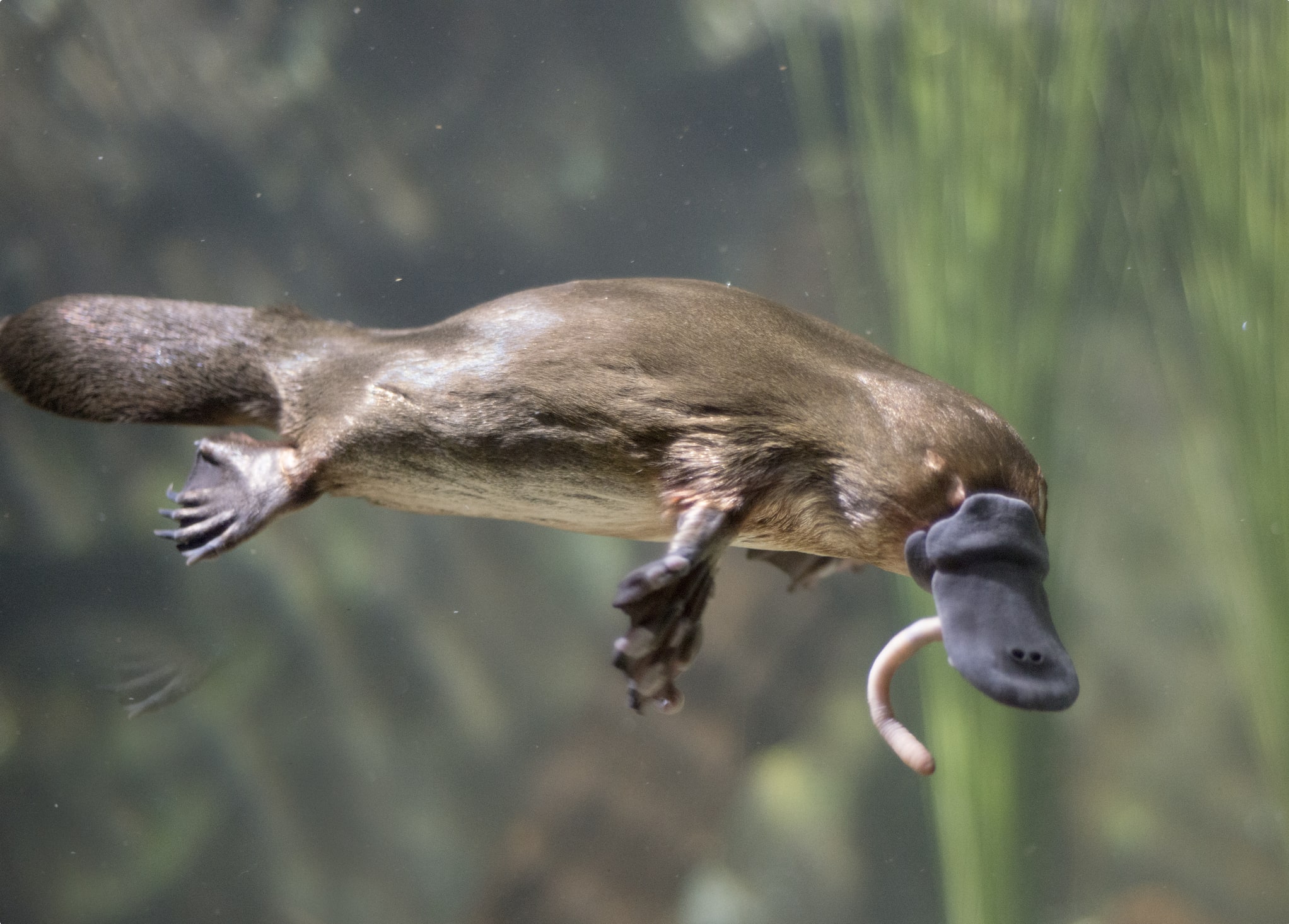
Echidna
Australia‘s second monotreme is the Echidna, found across Australia and Tasmania, the Echidna is also something of an evolutionary mishmash, with a short beak like a bird, long tongue like an anteater, spines like a hedgehog, a pouch like a kangaroo, as well as laying eggs. The echidna evolved from a similar aquatic ancestor as the platypus, though they’ve adapted to a life on land, mostly using their long sticky tongue to hunt insect larvae, ants, and termites. The echidna is a medium sized animal, weighing up to 7kg, and using its strong shovel shaped claws to dig out burrows, and crack into wood and mounds for termites and other insects. Interestingly, they have retained the electroreceptors of their ancestors, though on land this cannot be used to full effect. They are also still effective swimmers, able to use their long claws as something akin to paddles, to get across even deeper bodies of water. When feeling threatened, the echidna will roll up into a spiny ball, with its long spiny ‘hairs’ providing an excellent defence and deterrent for any would be predator.
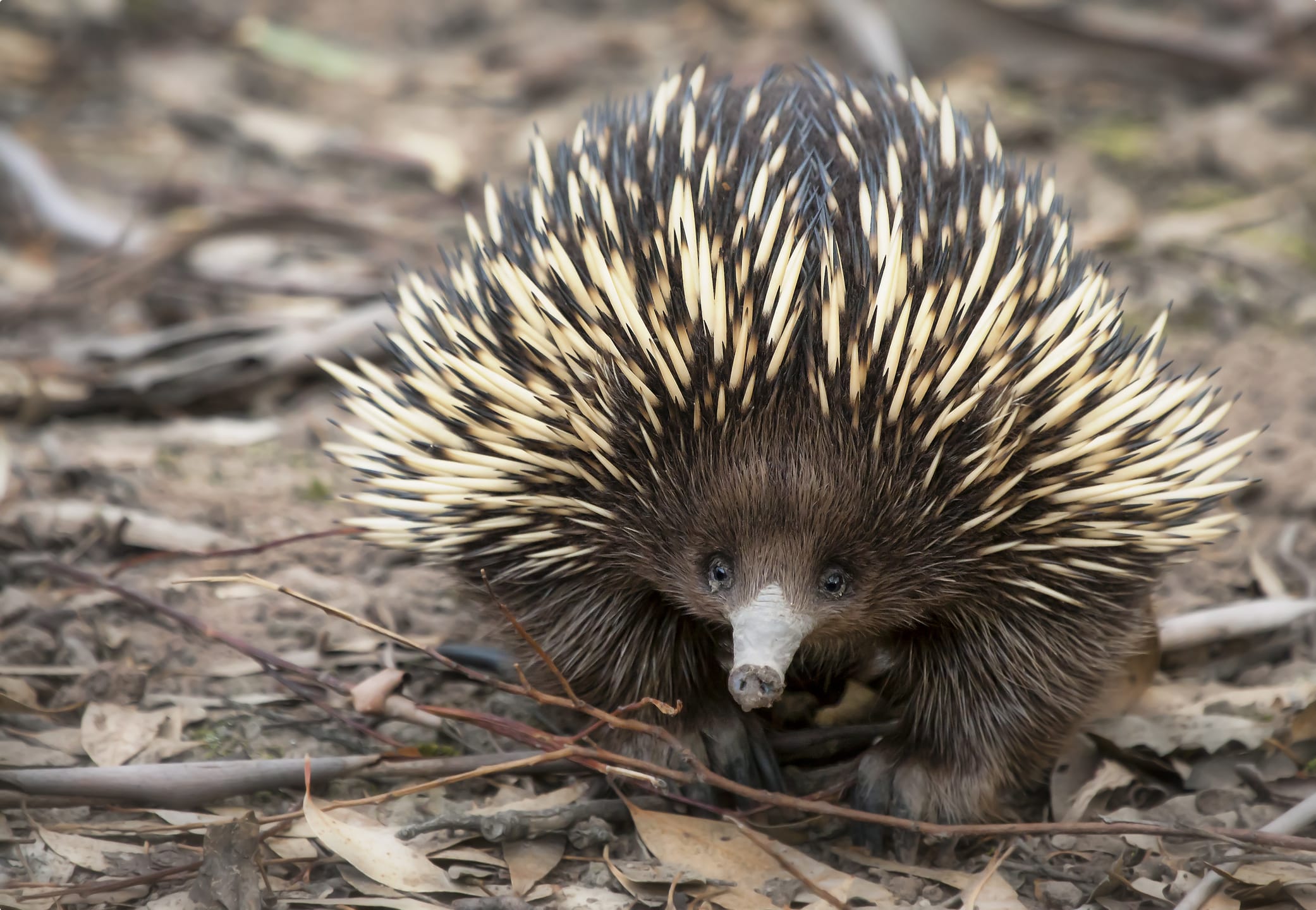
Articles about Australia published by Odyssey Traveller:
- The Kimberley: A Definitive Guide
- Uncovering the Ancient History of Aboriginal Australia
- Aboriginal Land Use in the Mallee
- Understanding Aboriginal Aquaculture
- Mallee and Mulga: Two Iconic and Typically Inland Australian Plant Communities (By Dr. Sandy Scott).
- Top 10 Natural Curiosities of Australia and New Zealand
For all the articles Odyssey Traveller has published for mature aged and senior travellers, click through on this link.
External articles to assist you on your visit to Australia:
Articles

Aboriginal Art
Senior and mature couples and solo travellers remain curious but often informed about the role Aboriginal art plays in the indigenous community and the various styles. This article seeks to provide a platform for this collection of small group tours of upto 15 people into the Australian outback where often Aboriginal art styles are encountered.

Aboriginal culture of the Flinders Ranges, South Australia
The iconic Flinders Ranges of South Australia have a rich Aboriginal heritage and are home to a number of vitally important cultural sites and ancient artworks that this small group tour for mature and senior travellers has the opportunity its to learn about.
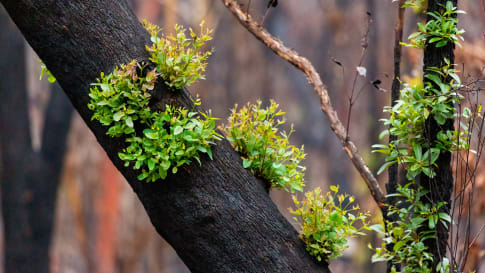
Aboriginal Fire Management
Small group tours for mature and senior travellers in the Australian outback to learn and appreciate land management techniques for couples and solo travellers reflecting Aboriginal culture in Kakadu, Tasmania, Arnhem land and the Kimberley.

Aboriginal history and culture of Kakadu National Park, Northern Territory
For those seek to learn as they travel then the history of the Aboriginal journey and timelines that unfold as a discovery in Australia seek to fascinate the mature and senior traveller on a small group package tour for couples and singles. From Darwin, this tour also visits Arnhem land as well as Kakadu, during the dry season.

Aboriginal Rock Art in the Kimberley, Australia
The Kimberley is explored on a small group tour for mature and senior travelers, couples or singles. Both Aboriginal community is studied and an appreciation of the wet and dry seasons. This guide on the Kimberley assists the traveler as you start from Broome and travel round via Halls creek and Purnunulu national park over some 17 days in a group of up to 12 people.
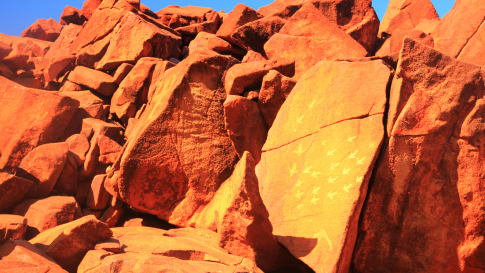
Aboriginal Stone Arrangements
Aboriginal stone arrangements are a form of rock art deliberately placed in position by Indigenous Australians and associated with spiritual ceremonies or utilitarian purposes. This article for mature and senior travellers provides and couples and solo travellers with and understanding and appreciation of the Ancient historic landscapes they are travelling though on a small group tour.

Albany and ANZAC, Western Australia
Albany is the southernmost town of Western Australia. The Wildflower small group tour visits this historic town with a strong ANZAC connection. Albany before the Swan River colony, later to be known as Perth.
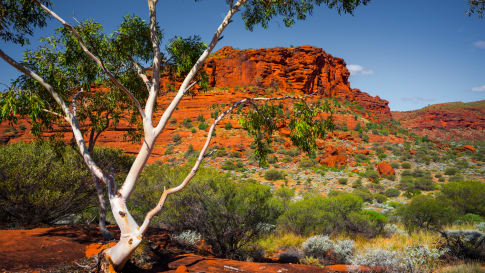
Alice Springs, Australia
Explore the sights and history of Alice Springs, with its amazing Indigenous art, rugged early settlement, and dramatic natural landscapes, Alice Springs is one of the Northern Territory's most popular highlights. Odyssey offers small group tours for mature and senior travellers, couples, and solo travelers to Australia and the Northern Territory.
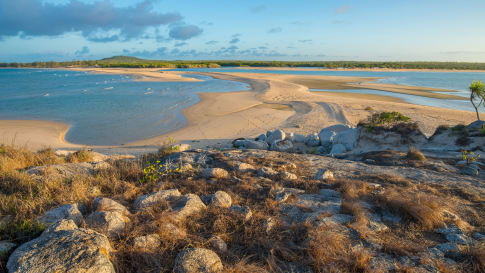
Arnhem Land, Northern Territory
To enter Arnhem land a permit is required for visitors. Explore and learn about the Aboriginal community in Arnhem land as part of a small group package tour that includes Darwin and the Kakadu. These are small group tours of upto 12 like minded mature and senior travellers, couples or solo travellers interested in exploring as they tour.

Barossa Valley and McLaren Vale Wine Regions, South Australia
This small group tour for mature and senior travellers for couples and solo travellers in Adelaide takes time to explore the two major wine-growing regions of South Australia, the Barossa Valley and the McLaren Vale.

Birding in Broome, Western Australia
Birding in Broome, Western Australia The town of Broome, in the remote north of Western Australia, is a birdwatcher’s paradise. Over 330 bird species have been recorded in and around Broome – more than one…

Bruny Island, Tasmania
Explore the sights and history of Bruny Island, with its soaring dolomite cliffs and white sand beaches, it is home to some of Tasmania's richest natural heritage. Odyssey offers small group tours for mature and senior travellers, couples, and solo travelers to Australia and Tasmania.

Charles Sturt and the search for the inland sea
Sturt is an iconic British explorer.From this article escorted small group tours for mature and senior travellers may join as couples or solo travellers programs that explore and share Aboriginal history, the landscapes and culture of the Australian outback with Stuart and Eyre, Burke and Wills and more.

Cradle Mountain, Tasmania
One of Tasmania's most iconic natural wilderness destinations. Explore Cradle mountain on a seniors small group tour of Tasmania designed for active couples and solo travellers or select another iconic Australian or New Zealand tour.
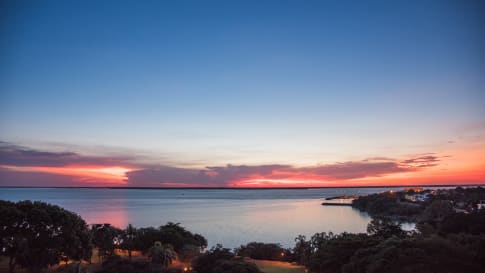
Darwin, Northern Territory
Discover Australia's Northern city whilst on a small group package tour to the Northern Territory with likeminded mature and senior travellers couples or singles. Darwin is the base for a tour of Kakadu and Arnhem land.

Flinders Island, Tasmania
Learn more about this island in the Bass strait as you prepare for week long small group walking tour of the island that begins and ends in Launceston. For fit mature and senior travellers, couples or singles with an interest wildlife and history.

Freycinet Peninsula, Tasmania
Small group tour of the Tasmanian wilderness for senior travellers. This tour for active couples and solo travellers explores Wineglass Bay on the Freycinet Peninsula is one of the jewels of Tasmania's east coast, walking a section of the bay of fires walk and learning about Aboriginal history.
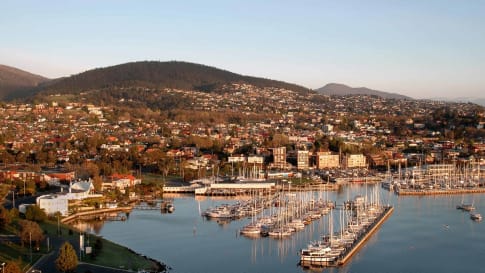
Hobart, Tasmania
Join some of many classes offered in the summer schools each January for a fortnight in this city or take a small group tour for senior and mature travelers of Tasmania wildlife & history.

Kangaroo Island, South Australia
Kangaroo Island is reached from Adelaide for a short break tours or view our small group tours of South Australia and/or Adelaide for senior and mature travellers.

Kununurra, Western Australia
Explore the sights and history of Kununurra, with its spectacular lakeside beauty and outback charm, Kununurra is one of the Kimberley's most popular highlights. Odyssey offers small group tours for mature and senior travellers, couples, and solo travelers to Australia and Western Australia.

Motorbike tours for the mature and senior traveller
Best Motorcycle tours for the mature and senior traveller. This is the time for that motorcycle trip you may have dreamt about becoming a reality.Odyssey Traveller offers you the opportunity to ride through some of…




